电力电子技术专业翻译
自动化英语--专业词汇的翻译
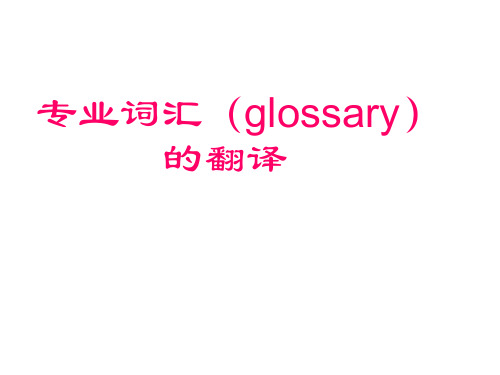
Trying:
• • • • • • • • 大学英语 C语言 计算机操作系统 数字信号处理 系统辨识 模糊控制 神经网络 计算机仿真 College english C language Computer operating system Digital signal processing system identification fuzzy control neural network computer simulation
2.专业课程名称的翻译
• 电机学 Theory of electric motors • 电力拖动基础 Fundamental of electric drive • 电力拖动自动控制系统 Automatic control system for electric drive • 单片机应用 application of single-chip computer • 可编程逻辑控制器 Programmable logical controller(PLC) • 半导体变流技术 Semiconductor converting Technique • 计算机接口技术 Computer Interface Technique
量子化学仍处于发展初期。
• 3) When polymers are fabricated into useful articles, they are referred to as plastics, rubbers, and fibers. 当聚合物加工成有用的制品时,就把它称为塑料、橡胶和纤维
1.专业术语的翻译
c、由人名构成的术语,一般采用音、意混合译法
Faraday constant 法拉第常数(恒量) Lenz's law 楞次定律 Joule-Thomson effect 焦耳-汤姆孙效应 • Mason Formula 梅森公式 • Routh approximation method 劳思近似判 据 • Nyquist stability criterion 奈奎斯特稳定判 据
电力系统及其自动化

电力系统及其自动化一、专业解析(一)学科简介电力系统及其自动化(电力工程及其自动化)是我们电力系统一直以来力求的发展方向,它包括:发电控制的自动化(AGC已经实现,尚需发展),电力调度的自动化(具有在线潮流监视,故障模拟的综合程序以及SCADA系统实现了配电网的自动化,现今最热门的变电站综合自动化即建设综自站,实现更好的无人值班.DTS即调度员培训仿真系统为调度员学习提供了方便)配电自动化(DAS已经实现尚待发展).本专业是强电和弱电、计算机技术与电气控制技术交叉渗透的综合型学科专业。
培养具有扎实的数学、物理和电气信息基础知识,在电气工程与信息领域从事电力系统运行与控制、信息处理、试验分析、研制开发等工作的复合型高级工程技术人才。
(二)培养目标培养在电力系统及其自动化领域能独立从事科研、教学、管理等工作的德智体全面发展的高层次专门人才。
具体要求是:1.具有电力系统及其自动化方面坚实的理论基础和系统的专业知识,了解本学科有关研究领域的国内外学术现状和发展方向;具有独立分析和解决本学科的专门技术问题的能力。
2.较为熟练地掌握一门外国语,能阅读本专业的外文资料。
3.具有健康的体魄和心理素质。
(三)研究方向各招生单位研究方向和考试科目不同,在此以华北电力大学为例:01电力系统分析、运行与控制02电力系统安全防御与恢复控制03电力经济分析04电力系统规划与可靠性05智能技术及其在电力系统中的应用06电力系统继电保护07电力系统自动化技术08电力系统故障分析与诊断09高压直流输电与柔性输配电技术10现代电能质量分析与控制技术11电力系统电磁兼容12特高压输变电技术(四)考试科目① 101政治② 201英语③ 301数学一④ 822电力系统分析基础二、推荐院校以下院校是该专业研究生院实力较强者,建议选报:华北电力大学、清华大学、西安交通大学、华中科技大学、西南交通大学、天津大学、浙江大学、武汉大学、华南理工大学、山东大学、哈尔滨工业大学、四川大学。
大学课程名中英文对照一览表
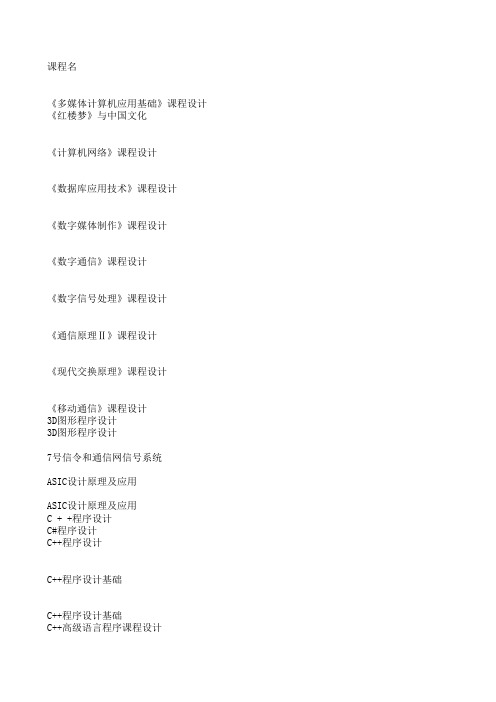
课程名《多媒体计算机应用基础》课程设计《红楼梦》与中国文化《计算机网络》课程设计《数据库应用技术》课程设计《数字媒体制作》课程设计《数字通信》课程设计《数字信号处理》课程设计《通信原理Ⅱ》课程设计《现代交换原理》课程设计《移动通信》课程设计3D图形程序设计3D图形程序设计7号信令和通信网信号系统ASIC设计原理及应用ASIC设计原理及应用C + +程序设计C#程序设计C++程序设计C++程序设计基础C++程序设计基础C++高级语言程序课程设计C++高级语言程序设计C++高级语言程序设计C++高级语言程序设计C++高级语言程序设计C++语言程序设计CAD/CAM技术CI策划Computer Networks and Internet C程序设计实践C程序设计实践C高级语言程序设计C高级语言程序设计C高级语言程序设计C高级语言程序设计C语言程序设计C语言程序设计C语言程序设计基础DSP技术DSP设计及应用DSP原理与应用DSP原理与应用EDA技术ERP沙盘模拟实战ERP沙盘模拟与价值管理ERP原理与应用Flash动画编程Flash动画制作ICT管制Internet 技术Internet 应用基础Internet 应用技术Internet服务质量与NS2仿真INTERNET技术Internet技术与网页制作IP电话与软交换IT服务管理IT企业文化教育Java EE平台技术Java SE 程序设计实践JAVA编程JAVA程序设计JAVA程序设计JAVA高级语言程序设计JAVA高级语言程序设计JAVA高级语言程序设计Java高级语言程序设计Java网络编程JAVA语言程序设计Java语言与编程Java语言与程序设计LABVIEW虚拟实验系统的设计Linux 操作系统Linux 操作系统LINUX操作系统Linux环境及开发工具应用实践Linux系统与程序设计Linux系统与程序设计Linux系统与程序设计基础Linux系统与程序设计基础LSI/VLSI数字集成电路MATLAB程序设计MATLAB及其在通信中的应用MATLAB应用Matlab语言及其信号处理应用MATLAB在信号与系统课程中的应用Multisim电路设计软件Multisim电路设计软件应用NS2网络仿真方法office 开发技术Photoshop电脑美术基础SoC设计方法SoPC与嵌入式系统应用TCP/IP原理与编程UNIX编程环境Unix操作系统UNIX操作系统及应用UNIX原理与编程VI形象设计VLSI原理与CAD技术VLSI原理与EDA技术WEB编程Web开发技术WEB搜索技术WINDOWS NT 系统管理WINDOWS NT系统管理WTO法XML&WebserviceXML及其应用安全及认证安全及验证安全教育办公自动化半导体器件电子学半导体器件物理半导体物理半正定规划保险学报刊选读比较政府体制毕业论文毕业论文毕业论文毕业论文毕业论文毕业论文毕业设计毕业设计毕业设计毕业设计毕业设计毕业设计毕业设计毕业设计毕业设计毕业设计毕业设计毕业设计毕业设计毕业设计毕业设计(上)毕业设计(上)毕业设计(上)毕业设计(下)毕业设计(下)毕业设计(下)毕业设计Ⅱ毕业设计Ⅱ毕业实习编码理论编码理论编码理论编译原理与技术编译原理与技术编译原理与技术编译原理与技术编译原理与技术课程设计并行计算并元理论材料力学财务管理财务管理财务会计财政学财政学财政与税收采购管理操作系统操作系统操作系统操作系统基础操作系统课程设计操作系统原理测控电路测控电路课程设计测控电子工艺实习测控技术课程设计测控软件设计实践测控系统课程设计测控仪器设计测试与检测技术基础测试与检测技术基础产品概念设计产品结构设计与表达产品开发产品开发产品开发设计产品设计(二)(信息产品)产品设计(三)(结构设计)产品设计(一)产品设计课程设计(产品、数字媒体)产品设计课程设计(产品/交互)产品摄影产品系统设计产品与品牌管理产业经济学常微分方程常微分方程成本会计程序设计基础程序设计基础程序设计课程设计程序设计实践程序设计实践程序设计语言原理与实践冲压工艺与模具设计抽样调查初等软件工程实践传感技术与应用传感技术与应用传感器网络传媒与经济传送网技术创新管理创新实验创业管理创意训练创作写作大客户营销与客户关系管理讲座大气化学与环境保护大型程序设计大型程序设计大型程序设计(二)大型程序设计(二)大型程序设计(一)大型程序设计(一)大学俄语1大学俄语2大学俄语一外1大学俄语一外2大学俄语一外3大学俄语一外4大学国文大学计算机基础大学计算机基础大学计算机基础大学美学大学日语1大学日语2大学日语3大学日语4大学日语一外1大学日语一外2大学日语一外3大学日语一外4大学生安全教育大学生心理健康教育大学生心理健康与咨询大学数学(上)大学数学(下)大学物理大学物理 (双语)大学物理(上)大学物理(下)大学物理(选修)大学物理A班大学物理B(上)大学物理B(上)A班大学物理B(上)双语班大学物理B(下)大学物理B(下)A班大学物理B(下)双语班大学物理C大学物理D(上)大学物理D(下)大学物理E大学物理解题法大学物理解题方法(上)大学物理解题方法(下)大学物理拓展与应用大学物理拓展与应用大学学习论大学学习论大学英语1-2级大学英语2大学英语3大学英语3-4级大学英语4大学英语5大学英语5大学英语二级大学英语二级大学英语二外1大学英语二外2大学英语二外3大学英语二外4大学英语二外5大学英语二外6大学英语三、四级大学英语三级大学英语四级大学英语听力口语测试大学英语五级大学英语选修大学英语一、二级大学英语一级大学英语一级大学语文大学语文大学语文水平测试大学语文水平测试大众传播学单片机C语言及应用系统设计单片机原理及PLC控制单片机原理及应用单片机原理与系统设计当代国际关系当代世界经济与政治当代世界经济与政治当代西方哲学当代中国外交当代中国政府与行政笛子演奏基本技巧典型机构分析点集拓扑学电波传播电波传播电磁场理论与微波技术电磁场实验电磁场与电磁波电磁场与电磁波电磁场与电磁波测量实验电磁场与微波技术实验电磁场与无线通信原理电磁兼容原理电磁学电磁学电动力学电动力学电机控制电接触、电连接理论电接触及电连接理论与应用电接触与电连接基础电力电子技术电路分析电路分析基础电路分析基础电路分析基础(双语)电路分析与电子电路电路分析与电子电路基础电路分析与电子电路基础电路辅助设计与仿真电路基础电路基础程序设计电路课程设计电路与电子学基础电路与电子学实验电路与信号电路综合创新实验电路综合设计类课程设计电路综合设计应用电路综合实验电路综合实验电路综合实验电路综合实验电路综合实验(1)电路综合实验(2)电信传播学电信法电信管理电信管制理论与政策电信基础电信竞争与规制电信企业资本运营电信企业资本运营电信市场竞争与规制电信系统电信系统电信新业务及技术电信与互联网基础电信运营管理电信组织管理电影欣赏电子材料学基础电子测量与电子电路实验电子测量与电子电路实验(上)电子测量与电子电路实验(上)电子测量与电子电路实验(下)电子测量与电子电路实验(下)电子电路基础电子电路基础电子电路基础电子电路自动化设计与VHDL语言电子废弃物的资源化电子工艺实习电子工艺实习电子工艺实习电子工艺实习电子工艺实习1电子工艺实习2电子及电磁场理论电子科学与技术专业课程设计电子科学与技术专业实验电子商务电子商务电子商务安全管理电子商务法电子商务法电子商务法电子商务法电子商务法电子商务概论电子商务概论电子商务概论电子商务开发技术电子商务模拟电子商务实习电子商务实习电子商务网站设计基础电子商务物流管理电子商务物流组织与管理电子商务系统建设与管理电子商务系统与技术电子商务与安全协议电子商务与电子金融电子商务与网络营销电子商务与网络营销电子设备机构设计(二)电子设备机构设计(一)电子设备结构设计电子设备结构设计(二)电子设备结构设计(一)电子系统基础电子线路设计与仿真电子信息科学与技术专业课程设计电子信息科学与技术专业实验电子信息系统概论电子学导论电子证据法概论电子政务电子政务网站设计基础电子政务网站设计实验电子政务专题讲座电子支付与网络金融调幅调频及立体声广播东西方数学文化选讲动画编剧动画场景设计动画创作动画创作动画创作实践动画概论动画技法动画技法(上)动画技法(下)动画脚本程序设计动画片赏析动画原理动画原理动画原理动漫创作综合实践动漫艺术分析动漫音乐评析短片创作短片配乐对称密码技术对称密码学及其应用多媒体和数字电视类课程设计多媒体计算机应用基础多媒体技术多媒体技术多媒体技术应用基础多媒体技术与应用多媒体技术与应用多媒体技术与应用多媒体通信多媒体通信多媒体通信类课程设计多媒体通信专业综合实验多媒体网络编程多媒体网页设计多媒体系统多媒体系统多媒体信息处理多媒体信息处理多媒体信息处理与传输多媒体信息处理与传输多媒体应用程序设计多模态信息处理多模态信息处理多元统计分析俄罗斯国情与文化概况俄语二外1俄语二外2俄语二外3二维动画创作实践二维动画制作基础发展经济学发展经济学法理学法律基础法律事业认识实习法律思想史法学论文写作技巧法语二外法语二外法语二外1法语二外2法语二外3法哲学与法社会学翻译基础翻译理论与实践 1翻译理论与实践 2翻译理论与实践(1)翻译理论与实践(2)翻译实践犯罪心理学犯罪学泛函分析仿真技术应用非线性编辑非线性光学非线性光学导论非线性光学导论非线性微分方程非线性物理非线性物理学非线性最优化方法非营利组织管理分布式计算分布式计算分布式系统分布式系统分子细胞生物学风险理论风险投资与管理服务科学与服务工程概论服务科学与工程服务营销学复变函数复变函数复变函数复杂问题的算法及程序设计概率论与数理统计概率论与数理统计概率论与数理统计概率论与随机过程概率论与随机过程高层网络协议高等代数高等代数(上)高等代数(下)高等软件工程实践高等数学(上)高等数学(上)高等数学(文上)高等数学(文下)高等数学(下)高等数学(下)高等数学A(上)高等数学A(下)高等数学B(上)高等数学B(下)高等数学解题法高等数学解题法(上)高等数学解题法(下)高等数学解题方法高等数学解题方法(下)高等统计学高级变换高级变换高级财务会计高级日语1高级日语2高级商务英语高级商务英语(双语)高级网络程序设计高级网络程序设计高级物理实验高级英语1高级英语2高频电子线路个人发展计划Ⅰ个人发展计划II个人发展计划III个体软件过程工程材料工程高等代数工程管理概论工程光学工程光学(二)工程光学(一)工程经济学工程力学工程力学与材料工程数学工程图学工程图学工程图学(二)工程图学(上)工程图学(下)工程图学(一)工程图学辅导工程项目管理实训工程项目监理工程制图基础工业机器人工业设计导论工业自动化系统课程设计工业自动化与控制网络工作分析与绩效管理工作站技术及其应用公共财政公共法语二外1公共法语二外2公共关系学公共关系学公共日语二外1公共日语二外2公共事业管理概论公共信息管理专题讲座公共行政学公共形体与礼仪公共政策公共政策公司并购法理论与实务公司法公司理财公司理财学公司运营与管理公司治理公文写作公益劳动公钥密码技术及其应用公钥密码应用供应链管理供应链管理构成设计(上)构成设计(下)构形与造型设计赏析固体物理固体物理学固体物理与半导体物理固网与移动网融合技术管理沟通管理沟通(双语)管理会计学管理经济学管理经济学管理前沿理论(第五项修炼)管理实习管理实习管理文秘管理心理学管理心理学管理信息系统管理信息系统课程设计管理学管理学概论管理学概论管理学原理管理学原理管理研讨光波导原理光波导原理与技术光传送与接入技术光电检测技术光电检测与传感技术光电检测与传感技术光电信息科学专题讲座光电子器件与集成技术光电子器件原理及应用光电子学光电子学光电子学光计算机简介光交换技术光通信的物理基础光网络基础光网络技术光纤通信光纤通信基础光纤通信类课程设计光纤通信网络光纤通信系统光纤通信系统光纤通信原理光信息处理光信息科学与技术专业课程设计光信息科学与技术专业实验光学光学光学光学系统与光电仪器光学系统与光电仪器光学信息处理广播电视艺术广告策划广告设计广告学与广告设计广告学与广告设计广告与营销策划国际电信服务贸易国际法国际法学国际会计国际会议交流英语国际结算国际结算国际金融学国际经济法国际经济法国际经济合作国际经济学国际经济学(双语)国际贸易国际贸易理论与实务国际贸易理论与实务国际贸易模拟国际贸易与国际金融国际贸易与国际金融国际贸易与金融国际企业管理国际商法国际商务函电国际商务函电(双语)国际商务礼仪国际商务礼仪国际商务礼仪(英文授课)国际市场研究国际市场营销国际市场营销国际市场营销学国际私法国际私法国际投资国际投资学国家大学英语四级考试国家大学英语四级考试国家地理资源国家公务员制度国家日语四级国家英语六级统考国家英语四级统考过程控制汉语阅读与写作航天技术概论合唱训练与指挥合同法合同法宏观经济学互动多媒体设计(二)互动多媒体设计(一)互动媒体课程设计互动媒体设计(二)互动媒体设计(一)互换性与测量技术互联网(社会)概论互联网编程互联网数据库互联网协议互联网协议互联网应用互联网应用环境法环境物理汇编语言与接口技术会计报表分析会计报表分析会计电算化会计电算化会计电算化与ERP沙盘模拟会计学会计学会计学基础会计学基础与模拟会计综合实训婚姻家庭法混沌计算混沌理论及其应用货币银行学机电控制系统机电一体化机器人嵌入式系统实验机器人系统综合实验机器视觉机器学习机器智能机械创新设计机械设计机械设计基础机械设计基础实验机械设计课程设计机械设计课程设计机械原理机械原理及设计机械原理课程设计机械制造工程基础机械制造工艺实习机械制造工艺实习机械制造基础机械制造基础(上)机械制造基础(下)机制工艺课程设计机制工艺实习基础会计学基础力学实验基础日语1基础日语2基础日语2基础日语3基础日语4基础设计基础素描基础英语(二)基础英语(一)基础英语1基础英语2基础英语3基础英语4基于C/C++语言的编程实践基于多媒体信息检索平台的设计激光光谱激光技术激光原理激光原理与技术激光原理与技术集成电路工艺及电子化学品集成电路设计概论集成电路制造技术集散控制系统集体创作集邮学集邮学计量经济学计量经济学计算导论与程序设计计算方法计算方法程序设计计算机3D造型设计计算机病毒及其防治计算机病毒及其防治计算机操作基础和程序设计计算机导论计算机犯罪计算机犯罪计算机仿真计算机仿真计算机仿真计算机辅助工业设计(二)计算机辅助工业设计(一)计算机辅助机械工程计算机工程实践计算机工程实践计算机和网络类课程设计计算机检测控制系统课程设计计算机检测控制系统课程设计(上)计算机控制仿真课程设计计算机控制系统计算机控制系统计算机控制系统设计计算机类课程设计计算机立体辅助设计计算机平面辅助设计计算机软件技术基础计算机实习计算机实习计算机实习计算机实习计算机实习计算机实习计算机实习计算机实习计算机实习计算机视觉计算机算法与数学模型计算机算法与数学模型计算机算法与数学模型(上)计算机算法与数学模型(下)计算机通信与网络计算机通信与网络实验计算机图形图像处理计算机图形学计算机图形学计算机图形学计算机图形学计算机图形学基础计算机图形学基础计算机网络计算机网络计算机网络计算机网络计算机网络计算机网络基础计算机网络技术实践计算机网络技术与应用计算机网络技术与应用计算机网络课程设计计算机网络课程设计计算机网络课程设计计算机网络实验计算机网络与通信计算机文化基础计算机系统结构计算机系统结构计算机系统结构计算机应用基础计算机游戏开发计算机与办公自动化计算机原理计算机组成与系统结构计算机组成与系统结构计算机组成原理计算机组成原理计算机组成原理计算机组成原理课程设计计算机组成原理与系统结构计算机组织与结构计算机组织与结构计算数学计算物理与实践计算物理与实践计算智能计算智能技术经济学技术经济学技术美学价格管理讲座价值评估与管理检测技术与信号处理检测与估值检测与估值理论健美健美操交互设计交互式媒体设计交互式媒体设计交互式网页设计交换网络与性能分析交流技能1交流技能2角色与场景设计脚本设计接口技术课程设计接入网技术界面设计金工实习金工实习金工实习金融法金融风险管理金融工程与风险管理金融市场金融数学金融学金融学金融学金属腐蚀和防护近代光学近代物理基础近代物理实验近代物理实验(续)近世代数近世代数及其应用近世代数及其应用经典英文电影赏析经济法经济法经济法经济法概论经济法学经济管理经济管理论文研究与写作方法经济管理综合案例分析经济统计学经济学经济学原理精密机械与仪器精密机械与仪器课程设计精算数学精算学基础竞争情报技术镜头画面设计镜头画面设计I镜头画面设计II就业指导就业指导矩阵理论剧作结构分析决策分析军事理论军训军训科技法科技史与方法学科技史与方法学科技文献检索与利用科技文献阅读与翻译科技英语笔译科技英语口译科技英语文献阅读与翻译科技英语阅读科学计算与Fortran语言科学计算与编程科学技术史可编程逻辑设计可用性测试技术客户关系管理客户关系管理前沿课程设计课程设计课程设计空间解析几何控制工程基础控制原理跨国财务管理跨国公司财务管理跨国经营跨文化交际实用技能跨文化交际学宽带接入网宽带通信网宽带通信网络宽带网络与媒体传输扩频通信篮球劳动法和社会保障法劳动合同法学乐理垒球离散多元分析离散计算机技术离散计算技术离散事件控制系统离散数学离散数学离散数学离散数学离散数学离散数学(上)离散数学(下)离散数学(下)礼仪与形象理解人际沟通理论力学理论力学力学历史管理学立体构成立体构成量子力学量子力学量子力学导论量子力学与统计物理量子力学专题讲座量子信息基础量子信息科学领导学领导学概论流体传动与控制旅游日语马克思主义基本原理马克思主义哲学原理马克思主义政治经济学原理毛泽东思想、邓小平理论和“三个代表”重要思想(上)毛泽东思想、邓小平理论和“三个代表”重要思想(上)(实践)毛泽东思想、邓小平理论和“三个代表”重要思想(下)毛泽东思想、邓小平理论和“三个代表”重要思想概论(下)(实践)毛泽东思想概论毛泽东思想和中国特色社会主义理论体系概论毛泽东思想和中国特色社会主义理论体系概论(实践)贸易实务操作实训贸易实务操作实验美国经济、商业与股市的理解与分析美国文学美国文学简史及选读美术基础与欣赏美术鉴赏美术经典作品鉴赏美术造型基础(上)美术造型基础(下)美学概论秘书学面向对象程序设计面向对象程序设计面向对象程序设计方法面向对象程序设计与交互系统面向对象程序设计与实践(C++)1面向对象程序设计与实践(C++)2面向对象程序设计与实践1面向对象程序设计与实践2面向对象大型程序设计实践面向对象的UML与JAVA面向对象的UML与JAVA面向对象的分析与设计面向对象方法与C++面向对象分析与设计面向对象分析与设计(Java)面向领域的实践1面向领域的实践2民法分论民法学(上)民法学(下)民法总论民事诉讼法模糊集合与灰色系统应用模糊数学模拟电子技术模拟电子技术模拟法庭模拟集成电路设计模式分析模式识别模式识别模式识别模式识别及应用模式识别及应用模型制作纳米材料与技术纳米技术与纳米材料脑与认知科学基础脑与认知科学认识实验排队论排队论排球偏微分方程品牌管理与CI策划乒乓球平面构成平面构成企业ERP及应用企业电子商务管理企业管理企业管理企业管理。
电子电工专业英语
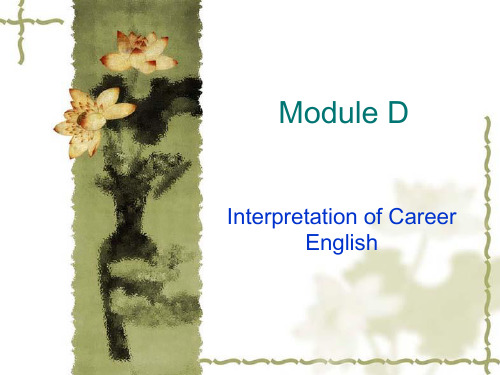
Unit 26 Expressions of Passive Voice 被动语态的几种表达方式
(1)典型的“be+动词过去分词”的被动结构,这种句子往 往在翻译中加入“被、由、受、用”等词以表达被动的意思, 一般采用直译的方法,例如:
The parts of CPU are usually connected by an electronic component referred to as a bus. 中央处理器的各部件通常是由一种(被)称为总线的电子器件连接 的。
(4)非谓语结构在专业英语中使用很广,有时也用来表达 被动意思,例如:
Programmer only needs to tell the computer what to be executed. 程序员只需告诉计算机执行什么任务。 Once your floppy disk being formatted, it can be used to store data. 软盘一经格式化后就可以用来储存数据。
微机原理(Principle of Microcomputer) 计算机控制技术(Computer Control Techniques) 自动调节装置(Automatic Regulators) 过程控制系统(Process Control System) 电气自动控制(Electrical Automatic Control) 电力拖动基础(Fundamental of Electric Drive) 交流调速系统(AC Motor Speed Regulating System) 电力拖动自动控制系统(Automatic Control System for Automatic Electric Drive) 单片机应用(Application of Single-chip Computer) 可编程控制器系统(Programmable Logical Controller System) 供电技术(Power Supplying Technology) 计算机仿真(Computer Simulation) 楼宇自动化(Building Automation) 线性系统(Linear System)
自动化专业英语--专业词汇

,
pole-zero
次技术词汇
很多专业和学科所共有的词汇,不同专业和学科往往 具有不同词义
power : 幂,乘方 电源,电力,功率,电能 动力,功率,效率 bus: 公共汽车 母线,总线
Condenser: 电容器,补偿机 冷凝器 power plant: 发电厂 动力装臵
Vocabulary Features
-er, -or
driver驱动器, capacitor电容器,conductor 导体,reactor反应器,breaker断路器, disconnector断路器,operator算子
形容词后缀
词缀 -able, -ible -ous 含义 例词 measurable可测量的, convertible可逆的 continuous继续的;synchronous 同步的 electriferous带电的 simultaneous同时的 powerful强大的,useful有用的 colorless无色的
1.专业术语的翻译
a、计量单位名称(一般采用音译)
hertz volt ampere newton...
b、各种新型材料名词一般用音译 nylon-尼龙, Valve-阀(门) X-ray x光,radar-雷达 vaseline-凡士林,uranium-铀 morphine-吗啡,heroin-海洛因 Penicilliin-盘尼西林(青霉素)
专业英语翻译标准
准确明白:准确无误、清楚明白地表达原文含义。必须 正确理解原文,使译文不产生歧义 通顺严密:译文的选词造句符合汉语的要求和习惯,语 言通畅又严密 简练全面:译文要简洁精炼,同时力求全面不遗漏
1. 2. 3. 4. 5. 6. 7.
实验室专业术语中英文翻译对照

实验室专业术语中英文翻译对照自动化实验室Automation Lab语言实验室Language Lab现代产品设计与制造技术实验室Modern Product Design & Manufacturing Tec hnology Lab计算机集成制造实验室Computer Integrated Manufac turing Sy stem Lab先进设计技术实验室Adv anced Design Tec hnology Lab机械设计基础实验室Machine Design Lab包装工程实验室Pac k ing Engineering Lab机械制造技术实验室Machine Manufacturing Lab精密机械测量技术实验室Precise Mac hine M easuring Tec hnology Lab数控技术与传动控制实验室NC Technol ogy & Trans mission C ontrol Lab设计创新实验室Innov ati on & Practic e Lab机械CAD中心Mechanic al CAD Center工作设计与时间研究实验室Job Design & Time Study Lab企业资源规划实验室Enterprise Resource Planning Lab系统仿真与设施规划实验室Sy s tem Si mulation & Facility Layout Lab人因工程实验室Human Fac tors & Ergonomics Lab液压与气动实验室Hy draulic & Pneumatic Lab汽车性能和结构实验室Auto Performanc e & C onstruc tion Lab发动机性能实验室Engine Perfor mance Lab汽车电子电气实验室Auto Elec tronic & Electric Lab数字媒体技术实验室Digital Media Technolog y Lab数字媒体技术基础实验分室Digital Media Technolog y Foundati on Lab数字影视实验分室Digital TV & Film Lab计算机动画与虚拟现实实验室Computer Animation & Virtual Reality Lab先进控制技术实验室Adv anced Control Tec hnology Lab楼宇智能化实验分室Intelligent Buildi ng Lab智能测控实验分室Intelligent Meas urement & Control Technolog y Lab运动控制与图象识别系统实验分室Motion C ontrol & Image R ecognition Sy stem Lab控制网络实验分室Control Network Lab自动控制系统实验分室Automatic Control System Lab自动控制原理实验分室Automatic Control Principl e Lab自动化学科创新实验室Automation Subject Innovation Lab电力电子技术分室Power El ectronics Technolog y Lab计算机控制技术实验分室Computer Control Technolog y Lab高压实验室High Voltage Technolog y Lab电机与控制实验室Electrical Machi ner y & C ontrol Lab电路与系统实验室Circuitry & Sy stem LabIC设计实验室IC Design LabESDA 与嵌入式技术实验室ESDA & Embedded Technolog y Lab微机原理实验室Microcomputer Principle Lab电力系统继电保护实验室Power Sy s tem Relay Protection Lab供配电技术实验室Power Supply Lab电力系统仿真实验室Power Sy s tem Emul ation Lab基础化学实验室Basic Chemistr y Lab无机化学分室Inorganic Chemistry Lab有机化学分室Organic Chemistry Lab基础分析化学分室Basic Analytical Chemistr y Lab物理化学分室Phy sical Chemistr y Lab综合仪器实验室Instrumental Lab化工原理实验室Chemic al Engineering Principle Lab化学工程与工艺实验室Chemic al Engineering & Tec hnology Lab食品科学与工程实验室Food Science & Engineering Lab生物工程实验室Biological Engineering Lab应用化学实验室Applied Chemistr y Lab制药工程实验室Phar mac y Engineering Lab清洁化学技术实验室Clean Chemical Tec hnol ogy Lab电动汽车研究实验室Electro-Motion Auto Res earch Lab电动汽车驱动性能检测分室Electro-Motion Auto Perfor manc e Tes t Lab现代信息技术实验室Modern Information Technol ogy Lab宽带及视频通信分室ADSL & Video Communic ation LabSDH技术分室SDH Technology Lab虚拟测试技术分室Virtual Test Technolog y Lab网络测控与光机电一体化分室Network Control & Electromec hanical Lab光电信息分室Photo-Electricity Infor mati on Technolog y Lab网络多媒体技术分室Network Multimedia Technolog y Lab生物特征图像识别技术分室Bio- Charac ter Image R ecognition Tec hnol ogy Lab EDA与DSP技术分室EDA & DSP Technolog y Lab现代通信技术实验室Modern C ommunicati on Technolog y Lab通信原理分室Communic ation Principl e Lab现代交换技术分室Modern Switch Tec hnolog y Lab无线通信分室Wireless Communic ation Tec hnol ogy Lab光纤通信分室Optic-Fiber Communic ation Lab移动通信分室Mobile Communic ation Lab网络通信与软件分室Network & Software Lab应用电子技术实验室Applied El ectronic Technolog y Lab信号与系统实验室Signal & Sy s tem Lab数字电视实验室Digital TV Lab微机测控技术实验室Microcomputer Measurement & Control Tec hnology Lab单片微机与嵌入式系统实验室Single Chip-Microcomputer & Embedded Sy stem Lab 动态测试与控制实验室Dy namic Test & Control Lab传感器与检测技术实验室Sens or & Measurement Technolog y Lab精密仪器与光电工程实验室Precise Instrument & Optoel ectronic Engineering Lab信息技术基础实验室IT Foundation Lab高频技术实验室High Frequenc y Tec hnol ogy Lab道路与桥梁工程实验室Highway & Bridge Engineering Lab给水排水工程实验室Water Suppl y & Was te Water Lab土木工程材料实验室Civ il Engineering Materials Lab唯雅诺自动化网建筑设备工程实验室Building Equipment Lab建筑学实验室Architectural Lab交通运输工程实验室Communic ation & Trans portation Lab结构工程实验室Structural Engineering Lab控制测量实验室Control Sur v ey Lab力学实验室Mechanics Lab流体力学实验室Hy drody namics Lab"S"技术实验室S Technolog y Lab岩土工程实验室Geotechnical Engineering Lab城市规划实验室Urban Pl anning Lab工程管理模拟实验室Engineering Management Si mulating Lab电子商务专业实验室Electronic C ommerc e Lab企业管理实验室Enter prise Management Lab地理信息系统实验室Geographic Information Sy stem Lab信息系统基础实验室Infor mati on Sy stems Lab会计手工模拟实验室Hand Acc ounting Imitati v e Lab计算机体系结构实验室Computer Architectures & Organization Lab计算机组成原理分室Computer Organization Lab接口与通讯分室Interface & Communic ation Lab智能工程分室Intelligent Engineering Lab微处理器设计分室Microprocessor Design Lab计算机软件工程实验室Computer Software Engineering Lab软件分室Computer Software Lab.图象处理和图形学分室Image Processi ng & Computer Gr aphics Lab网络安全分室Network Sec urity Lab软件项目管理分室Softwar e Projec t Management Lab现代计算机技术实验室Modern C omputer Tec hnol ogy LabSUN工作站分室SUN Wor k Station Lab计算机网络工程分室Computer Networ k Engineering Lab材料与能源学院热处理实验室Heat Treatment Lab金属腐蚀与防护实验室Metal Corrosion & Protec tion Lab金相显微镜实验室Metallographical Microscope Lab物理性能实验室Phy sical Pr operty Lab高分子材料制备实验室Pol y mer Materials Preparation Lab高分子材料结构与性能实验室Pol y mer Materials Str ucture & Properties Lab 高分子材料成型实验室Pol y mer Materials Processing Lab热工基础实验室Basic Ther mal Engineering Lab制冷与空调实验室Air Conditioning & R efrigeration Lab集成电路工艺实验室IC Process Lab电子元器件测试实验室Electronic D ev ice Measurement Lab电子薄膜材料实验室Electronic Fil m Materials Lab材料成型及控制实验室Material Proc essing & Control Lab模具技术实验室Die & Moul d Tec hnology Lab功能材料的制备与应用技术实验室非晶态材料分室Amor phous Materials Lab表面工程分室Surfac e Engineering Lab热型连铸分室Heated Mold Continuous C asting Lab储能材料分室Energy Storage M aterials Lab先进材料结构与性能分室Adv anced Materials Structure & Properties Lab 环境工程实验室Env ironmental Engineering Lab水污染控制工程分室Water Polluti on Control Lab大气污染控制工程分室Air Pollution Control Lab固体废物处理工程分室Solid Waste Treatment Lab噪声污染控制工程分室Noise Pollution Control Lab环境监测分室Env ironment Monitoring Lab环境科学实验室Env ironmental Scienc e Lab环境信息分室Env ironmental Information Sy stem Lab环境化学分室Env ironmental C hemistry Lab环境生物实验室Env ironmental Biolog y Lab大型精密仪器室Exactitude Apparatuses Room信息与计算科学实验室Infor mati on & Computati on Scienc e Lab光电技术实验室Optoelectronic Tec hnology Lab光信息技术实验室Technolog y of Optical Information Lab微电子技术实验室Microelectronic Tec hnology Lab电子技术综合实验室Electronic Technolog y Lab工业设计实验室Industrial Design Lab服装设计与工程实验室Apparel Design Lab基础造型实验室Fundamental Design Lab摄影分室Photography Lab陶艺设计与制作分室Pottery Design & F acture Lab环境艺术设计实验室Env ironment Design Lab视觉传达设计实验室Visual Communic ation Design Lab家具设计实验室Furniture D ecorati on Lab模拟法庭Mock Trial Room数码钢琴室Digital Piano Room社会工作实验室Social Wor k Lab工程训练实验教学示范中心Engineering Training Demons tration Center 铸造实习室Casting铣刨磨实习室Milling/ Planer/Grinder数控加工实习室CNC Machining数控编程实习室Programmi ng普通车床实习室Turning Lathe焊接实习室Welding钳工实习室Benc h Work热处理/金相分析实习室Heat Treatment & Microstructure压力加工实习室Forging测量实习室Measurement唯雅诺自动化网大学物理基础实验室College Phy sics F oundation Lab大学物理综合实验室College Phy sics Sy nthesized Lab电工电子实验中心Electrical & Electronic Ex perimental C enter电工基础实验室Electronic F oundation Lab电子技术实验室Electrical Technol ogy Lab电工与电子技术实训室Electrical & Electronic Training计算机基础实验中心Computer Ex perimental Center计算机基础实验室Computer Foundation Lab计算机组装实验室Computer Assembling Lab计算机组网实验室Computer Networ k Lab实验仪器名称中英文对照表仪器中文名称仪器英文名称英文缩写原子发射光谱仪Atomic Emission Spectrometer AES电感偶合等离子体发射光谱仪Inducti v e C oupl ed Plas ma Emission Spectrometer ICP直流等离子体发射光谱仪 Direct Current Pl asma Emission Spec trometer DCP紫外-可见光分光光度计 UV-Visible Spec trophotometer UV-Vis微波等离子体光谱仪 Microwave Induc tive Pl asma Emission Spectrometer MIP原子吸收光谱仪Atomic Absorption Spec troscopy AAS原子荧光光谱仪Atomic Fluoresc enc e Spectroscopy AF S傅里叶变换红外光谱仪FT-IR Spectrometer FTIR傅里叶变换拉曼光谱仪FT-Raman Spectrometer FTIR-Raman气相色谱仪 Gas Chromatograph GC高压/效液相色谱仪High Pressure/Performance Liquid Chr omatography HPLC离子色谱仪 Ion Chromatograph凝胶渗透色谱仪Gel Per meation Chromatograph GPC体积排阻色谱 Size Ex cl usion Chromatograph SECX射线荧光光谱仪 X-Ray Fluoresc enc e Spectrometer XRFX射线衍射仪X-Ray Diffractomer XRD同位素X荧光光谱仪Isotope X-Ray Fluoresc enc e Spectrometer电子能谱仪 Elec tron Energy Disperse Spectroscopy能谱仪 Energ y Disperse Spec troscopy ED S质谱仪 Mass Spec trometer MSICP-质谱联用仪ICP-MS IC P-MS 气相色谱-质谱联用仪 GC-MS GC-MS 液相色谱-质谱联用仪 LC-MS LC-MS 核磁共振波谱仪Nuclear Magnetic R esonanc e Spectrometer NMR电子顺磁共振波谱仪 Electron Paramagnetic Resonance Spectrometer ESR极谱仪 Polarograph伏安仪 Voltammerter自动滴定仪 Automatic Titrator电导仪 Conducti v ity MeterpH计 pH Meter水质分析仪 Water Tes t Kits电子显微镜 Elec tro Microscopy光学显微镜 Optical Microscopy金相显微镜 Metallurgical Microscopy扫描探针显微镜Sc anning Probe Microscopy表面分析仪 Surface Anal y z er无损检测仪 Ins trument for N ondestructi ve Testi ng物性分析Phy sical Property Anal y sis热分析仪Thermal Anal y zer粘度计 Visc ometer流变仪 Rheometer粒度分析仪 Particle Size Anal y zer热物理性能测定仪 Ther mal Phy sical Property Tester电性能测定仪 Electrical Property Tester光学性能测定仪Optical Property Tester机械性能测定仪Mechanic al Property Tes ter燃烧性能测定仪Combustion Property Tester老化性能测定仪Aging Property Tes ter生物技术分析 Biochemic al anal y sisPCR仪Instrument for Pol ymeras e Chain R eaction PCR DNA及蛋白质的测序和合成仪 Sequencers and Synthesizers for DNA and Protein传感器 Sens ors其他 Other/Miscellaneous流动分析与过程分析 Fl ow Anal y tic al and Pr ocess Anal y tical C hemistry气体分析Gas Anal y sis基本物理量测定Basic Phy sics样品处理Sample Handling金属/材料元素分析仪 Metal/material el emental anal y sis环境成分分析仪CHN Anal y sis发酵罐 F ermenter生物反应器 Bio-reactor摇床 Shak er离心机 Centrifuge超声破碎仪 Ultrasonic Cell Disruptor超低温冰箱 Ultra-low Temper ature Freezer恒温循环泵 Cons tant Temperature Circulator超滤器 Ultrahigh Purity Filter冻干机 Freeze Dr y ing Equipment部分收集器 Fraction Collector氨基酸测序仪 Protei n Sequenc er氨基酸组成分析仪 Ami no Acid Anal y z er多肽合成仪 Peptide s ynthesizerDNA测序仪 DNA SequencersDNA合成仪 DNA synthesizer紫外观察灯 Ultrav iolet Lamp唯雅诺自动化网化学发光仪 Chemiluminesc enc e Apparatus紫外检测仪 Ultrav iolet Detec tor电泳 Electr ophoresis酶标仪 ELIASACO2培养箱 CO2 Incubators倒置显微镜 Inverted Microscope超净工作台 Bechtop流式细胞仪 Flow C y tometer微生物自动分析系统 Automatic Analy z er for Microbes生化分析仪 Bioc hemical Anal y zer血气分析仪 Blood-gas Anal y zer电解质分析仪 Electrol y tic Anal y zer尿液分析仪 Urine Anal y zer临床药物浓度仪Anal y zer for Clinic Medicine Conc entration 血球计数器 Hematoc y te Counter实验室家具laborator y/lab fur niture威盛亚wilsonart台面countertop/wor k top实验台laborator y cas ewor k/cabinet中央台island bench边台wall benc h试剂架reagent s helf/rac k天平台balance tabl e仪器台instrument table通风系统v entilati on s y s tem通风柜/橱fume hood/c upboard药品柜medical (storage) c abinet/c upboard器皿柜v ess el cabinet气瓶柜gas cy linder (storage) c abinet实验凳laborator y/lab stool实验椅lab chair配件accessories。
课程翻译
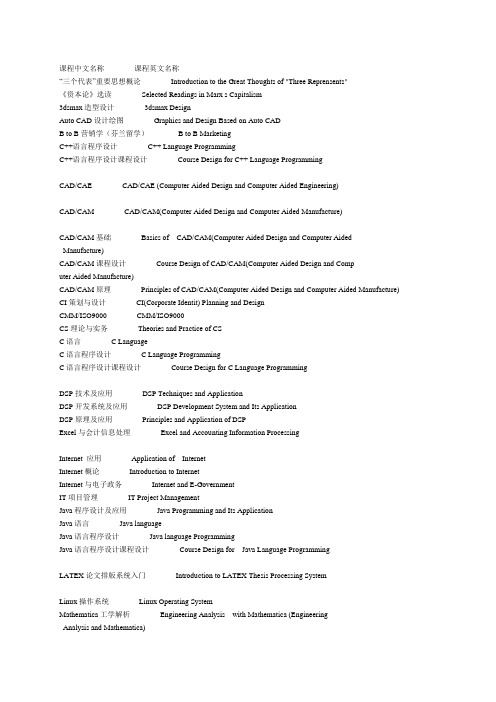
课程中文名称课程英文名称“三个代表”重要思想概论Introduction to the Great Thoughts of "Three Reprensents"《资本论》选读Selected Readings in Marx s Capitalism3dsmax造型设计3dsmax DesignAuto CAD设计绘图Graphics and Design Based on Auto CADB to B营销学(芬兰留学) B to B MarketingC++语言程序设计C++ Language ProgrammingC++语言程序设计课程设计Course Design for C++ Language ProgrammingCAD/CAE CAD/CAE (Computer Aided Design and Comp uter Aided Engineering)CAD/CAM CAD/CAM(Computer Aided Design and Computer Aided Manufacture)CAD/CAM基础Basics of CAD/CAM(Computer Aided Design and Computer Aided Manufacture)CAD/CAM课程设计Course Design of CAD/CAM(Computer Aided Design and Computer Aided Manufacture)CAD/CAM原理Principles of CAD/CAM(Computer Aided Design and Computer Aided Manufacture) CI策划与设计CI(Corporate Identit) Planning and DesignCMM/ISO9000 CMM/ISO9000CS理论与实务Theories and Practice of CSC语言 C LanguageC语言程序设计 C Language ProgrammingC语言程序设计课程设计Course Design for C Language ProgrammingDSP技术及应用DSP Techniques and ApplicationDSP开发系统及应用DSP Development System and Its ApplicationDSP原理及应用Principles and Application of DSPExcel与会计信息处理Excel and Accounting Information ProcessingInternet 应用Application of InternetInternet概论Introduction to InternetInternet与电子政务Internet and E-GovernmentIT项目管理IT Project ManagementJava程序设计及应用Java Programming and Its ApplicationJava语言Java languageJava语言程序设计Java language ProgrammingJava语言程序设计课程设计Course Design for Java Language ProgrammingLATEX论文排版系统入门Introduction to LATEX Thesis Processing SystemLinux操作系统Linux Operating SystemMathematica工学解析Engineering Analysis with Mathematica (EngineeringAnalysis and Mathematica)MATLAB及工程分析MATLAB and Engineering AnalysisMIS开发工具与案例MIS Development Tools and CasesPB程序设计PB ProgrammingPLC原理及应用Principles and Application of PLCPOP广告设计POP Advertising DesignPro/ENGINEER Pro/Engineer softwarePro-E三维造型设计Three-Damensional Design with Pro/Engineer softwareSPSS统计分析"StatisticalProduct and Service Solutions Software"VB程序设计VB ProgrammingVB设计基础Basics of VB ProgrammingVisual Foxpro程序设计Visual Foxpro ProgrammingWeb技术Web TechniquesWeb数据库Web DatabaseWeb应用技术Web TechniquesWeb应用技术课程设计Course Design for Web TechniquesWindows程序设计(VB)Windows Programming (VB)WTO案例分析Analysis of WTO CasesWTO法律制度Law and Regulations of WTOWTO规则(英文讲授)Rules of WTO(in English)XML技术XML (Extensible Stylesheet Language) Techniques安保与消防系统Safety and Fire-control System办公自动化Office Automation包装CAD CAD(Computer Aided Design ) for Packaging包装测试技术Package-testing Techniques包装工艺学Packaging Technology包装管理与法规Management and Statute of Packaging包装过程自动化Automation of Packaging Process包装结构课程设计Course Design for Package Structure包装结构设计Package Structure Design包装设计Package Design包装印刷及后序加工Package Printing and Follow-up Processing包装装潢课程设计Course Design for Packaging Decoration包装装潢设计Packaging Decoration Design包装装潢设计基础Fundamentals of Packaging Decoration Design保险电算化Electronic Insurance保险法Insurance Law保险概论Introduction to Insurance保险会计学Insurance Accounting保险经营管理学Insurance Operation and Management保险精算学Actuarial Science of Insurance保险市场Insurance Market保险统计学Insurance Statistics保险学Insurance保险学原理Principles of Insurance保险制度比较Comparative Studies on Insurance Systems保险专题讲座Lectures on Insurance比较税制Comparative Taxation System笔译(汉-英)Translation (Chinese to English)笔译(汉-英二)Translation (Chinese to EnglishⅡ)笔译(汉-英一)Translation (Chinese to EnglishⅠ)笔译(英-汉)Translation (English to Chinese)笔译(英-汉二)Translation (English to Chinese Ⅱ)笔译(英-汉一)Translation (English to Chinese Ⅰ)笔译实习Translation Practice毕业论文Diploma Thesis毕业论文(设计)Diploma Project and Thesis毕业论文与设计Diploma Project and Thesis毕业设计Diploma Project毕业设计(论文)Diploma Project and Thesis毕业设计经济分析报告Diploma Project—Report of Economic Analysis毕业实习Practice on Diploma Project (Thesis)毕业实习(1)Practice on Diploma Project (Thesis)Ⅰ毕业实习(1)(01)(假期)Practice on Diploma Project (Thesis)Ⅰ毕业实习(1)(假期)Practice on Diploma Project (Thesis)Ⅰ毕业实习(2)Practice on Diploma Project (Thesis)Ⅱ毕业实习(2)(01)Practice on Diploma Project (Thesis)Ⅱ毕业实习(3)Practice on Diploma Project (Thesis)Ⅲ毕业实习、毕业论文Diploma Thesis and Practice毕业实习、毕业设计Diploma Project and Practice on It毕业实习、毕业设计(论文)Diploma Project (Thesis) and Practice毕业实习、毕业设计(论文)Diploma Project (Thesis) and Practice毕业实习、设计(论文)Diploma Project (Thesis) and Practice编排设计Layout Design of Publication编译原理Principles of Compiling表面活性剂化学Surfactant Chemistry表现技法Presentation Techniques播音学概论Introduction to Broadcasting播音与主持作品鉴赏Appreciation of Broadcasting and Hosting Art博览会考察周Exhibition Investigation Seminar博物馆考察周Museum Investigation Seminar博物馆展示设计Design of Museum Exhibition材料科学导论Introduction to Material Science材料力学Material Mechanics材料市场调研Survey of Material Market材料性能测试技术Techniques of Material Performance Measurement材料与工艺Materials and Material Processing Technology财产保险学Property Insurance财务报表分析Business Analysis with Finacial Statements财务管理学Financial Management财务会计学Financial Accounting财政学Public Finance财政与税收Public Finance and Taxation采购学Purchasing餐饮管理Catering Management操作系统Disk Operating System测绘Measurement and Drafting测控技术Measurement and Control Technology测试技术Testing Technology测试技术课程设计Course Design for Testing Technology产品结构设计Product Structure Design产品界面设计Product Interface Design产品开发设计Product Development Design产品设计Product Design产品设计(1)Product Design Ⅰ产品设计(2)Product Design Ⅱ产品设计(二)Product Design Ⅱ产品设计(三)Product Design Ⅲ产品设计(四)Product Design Ⅳ产品设计(一)Product Design Ⅰ产品设计程序与方法Procedure and Methodology of Product Design产品设计课程设计Course Exercises of Product Design产品设计与策划Product Design and Planning产品摄影Product Photography产品摄影实践Practice of Product Photography产品数字化设计技术Technology of Product Digital Design产品系统设计Product System Design产业经济学Industrial Economics车辆空调Vehicle Air-condition车辆人机环境工程学Vehicle Man-machine-evironment Engineering 车用动力概论Introduction to Vehicular Internal Combustion Engine 成本管理会计Cost and Managerial Accounting成本会计学Cost Accounting城市经济学Urban Economics抽样调查Sampling Survey出版概论Introduction to Publishing橱窗展示设计Window-exhibition Design传播心理学Communication Psychology传递过程原理Principles of Transfer Course传统工艺品鉴赏与收藏Appreciation and Collection of Traditional Crafts传统装饰工艺设计Traditional Decorative Craft Design创新设计Innovative Design创新设计概论Introduction to Innovative Design创造工程学Creative Engineering Mechanism Design创造思维与技法Creative Thinking and Techniques创造学Creatology大气污染控制工程Air Pollution Control Engineering大气污染气象学基础Fundamentals of Air Pollution Meteorology大学俄语(二)College Russian Ⅱ大学俄语(三)College Russian Ⅲ大学俄语(四)College Russian Ⅳ大学俄语(一)College Russian Ⅰ大学化学College Chemistry大学美育"College AestheticEducation"大学日语(二)College JapaneseⅡ大学日语(三)College Japanese Ⅲ大学日语(四)College Japanese Ⅳ大学日语(一)College Japanese Ⅰ大学生思想修养Moral Cultivation for College Students大学生心理健康与咨询Psychological Health and Counseling大学数学College Mathematics大学物理(一) College Physics Ⅰ大学英语(二) College English Ⅱ大学语文College Chinese大众传播学Mass Communication代谢调控Metabolism Control单片机及接口技术Mono-Chip Computer and Interface Techniques单片机及接口技术课程设计Course Design for Mono-Chip Computer and Inter face Techniques单片机原理Principles of Mono-Chip Computer单片机原理及接口技术Principles of Mono-Chip Computer and Interface Techniques 单片机原理及应用Principles and Application of Mono-Chip Computer单片机原理课程设计Course Design for Principles and Application of Mono-Chip Computer 当代世界经济与政治Contemporary International Economy and Politics当代台湾Studies on Modern Taiwan当代中国马克思主义Contemporary Marxism in China当代中国外交Contemporary Diplomacy in China当代中国哲学Contemporary Philosophy in China导游基础与业务Principles and Practice of Tourguiding邓小平理论概论Introduction to Deng Xiaoping s Theory地球科学导论Introduction to Earth Science第二外语(二)The Second Foreign Language Ⅱ电磁场与电磁波Electromagnetic Field and Electromagnetic Wave电工电子技术Electrical and Electronic Engineering电工电子课程设计Course Design for Electrical and Electronic Engineering电工电子学Electronics in Electrical Engineering电工技术Electrical Engineering电机及电力拖动基础Fundamentals of Electrical Machinery and ElectricalDrive电机与电力拖动基础Fundamentals of Electrical Machinery and ElectricalDrive电力电子技术Power Electronic Technology电路CAA CAA(Computer Aided Analysis) for Circuit电路计算机辅助分析与设计Computer Aided Analysis and Design for Circuit电路理论分析Theoretical Analysis for Circuit电路原理Principles of Circuit电脑美术设计Computer-based Art Design电脑平面设计Computer-based Graphic Design电气控制技术Electrical Control Technology电气控制技术课程设计Course Design for Electrical Control Technology电气控制与PLC Electrical Control and PLC(Programmable Logic Controller )电气控制与PLC课程设计Course Design for Electrical Control and PLC(Programmable Logic Controller )电气与PLC 控制Electrical and Programmable Logic Control电器及PLC控制技术Electrical Appliances and PLC(Programmable Logic Controller ) Technology电视播音与主持TV Broadcasting and Hosting电视画面研究TV Tableau Studies电视节目采编TV Programme Gathering and Editing电视节目策划与编导TV Programme Planning and Editing电视节目形态研究TV Programme Pattern Studies电视美学TV Aesthetics电视新闻TV News电影艺术欣赏Appreciation of Film Art电子工艺实习Practice on Electronic Working Technics电子技能训练(二)Electronic Technical Training电子技术Electronic Techniques电子技术CAD Electronic Techniques Based on CAD(Computer Aided Design)电子商务E-Commerce电子商务安全E-Commerce Security电子商务案例分析Case Analysis of E-Commerce电子商务法规与安全E-Commerce Regulations and Security电子商务概论Introduction to E-Commerce电子商务技术E-Commerce Technology电子商务技术课程设计Course Design for E-Commerce Technology电子商务模拟E-Commerce Modeling Operation电子商务系统规划与设计Systematic Planning and Scheming of E-Commerce电子商务系统规划与设计课程设计Course Design for Systematic Planning an d Scheming of E-Commerce电子设计自动化Automation of Electronical Design电子实习Practice on Electronic Technology雕塑Sculpture调查研究方法Methodology of Investigation and Research调香术Technology of Artificial Flavor Production东西方哲学比较Comparative Studies on Oriental and Western Philosophy动画设计Animation Design多媒体光盘课件Multimedia Disk Courseware多媒体计算机技术Multimedia Computer Technology多媒体技术基础Fundamentals of Multimedia Technology多媒体技术与应用Multimedia Technology and its Application多媒体设计Multimedia Design多媒体艺术设计Multimedia Art Design二十世纪英美文学选读Selected Readings from the 20th Century English and American Literature二外俄语(二)Russian as the Second Foreign Language Ⅱ二外法语(二)French as the Second Foreign Language Ⅱ二外日语Japanese as the Second Foreign Language发酵工程及产品"Fermentation Engineering and its Product"发酵工艺实验(分散进行)Experiments of Fermentation Technics()发酵食品技术Food Fermentation Technology发型Hairstyle发展经济学Economics on Development法理学Nomology法律基础Fundamentals of Law法律逻辑Legal Logics法律职业形象设计Image Design of Legistration-related Profession法学基础理论Fundamentals of Science of Law翻译理论Translation Theories犯罪心理学Criminological Psychology犯罪学Criminology饭店布局与设计Hotel Layout and Design饭店财务管理Hotel Financial Management饭店服务Hotel Service饭店工程与设备管理Hotel Project and Facility Management饭店经营与管理Hotel Operation and Management饭店前厅与客房管理Hotel Front Office and Room Department Management饭店人力资源管理Hotel Personnel Management饭店设备管理Hotel Facility Management饭店营销学Hotel Marketing房地产法Real Property Law房地产法律制度Real Property Legislation房地产经营与管理RealEstate Operation and Management仿生学Bionics分析化学Analytical Chemistry分析检测专题实验Experiments for Analytical Measurement分子生物学Molecular Biology芬兰语言和文化(芬兰留学)Finnish Language and Culture风险管理Risk Management风险理论与非寿险精算Risk Theories and Actuarial Mathematics of Non-lif e Insurance风险投资Risk Investment服务管理学Service Management服务连锁经营Service Chains Operation服装设计Fashion Design服装史History of Fashion Design[辅助管理决策系统Assistant System for Decision Making in Management复变函数Complex Function复变函数论Introduction to Complex Function复合材料Composite Materials概率论Probability概率论与数理统计Probability and Statistics高等代数与空间解析几何(二)"Advanced Algebra and SpaceAnalytic Geometry Ⅱ"高等数学(上)Advanced Mathematics Ⅰ高等数学(微积分)精讲Advanced Mathematics(Calculus)高分子材料加工工程设计Engineering Design of Polymer Material Processin g高分子材料进展Development of Polymer Materials高分子材料学Studies on Polymer Materials高分子材料研究方法Methodology in Polymer Material Studies高分子分子设计Polymer Design高分子工程设计概论Introduction to Polymer Engineering Design高分子化学Polymer Chemistry高分子化学及物理Polymer Chemistry and Physics高分子涂料Polymer Coating高分子物理Polymer Physics高分子物理实验Experiments for Polymer Physics高分子原料与助剂Polymer Materials and Aids高分子粘合剂Polymer Adhensive高级财务会计学Advanced Financial Accounting高级听力Advanced Listening高级写作Advanced Writing高级英语Advanced English高级英语口语Advanced Speaking高级语言程序设计Programming of Advanced Computer Languages高级运筹学Advanced Operation Research高技术产品营销High-tech Manufacture Marketing高聚物共混改性原理Principles of Polymer Blending Modification高聚物现代仪器分析方法Methodology of Modern Instrumental Analysis for Polymer高频电子线路High-frenquency Electronic Technology歌剧赏析Appreciation of Operas工厂供电Power Supplying for Factory工厂供电课程设计Course Design for Power Supplying for Factory工程材料Engineering Materials工程化学Engineering Chemistry工程环境Engineering Environment工程经济学Engineering Economics工程力学Engineering Mechanics工程设计概论Introduction to Engineering Design工程设计软件Software for Engineering Design工程塑料Engineering Plastics工程制图Engineering Drawing工程制图实践Practice on Engineering Drawing工商管理专题研究Research on Business Management工业产品造型设计Modeling Design of Industrial Products工业产权法Industrial Property Law工业分析Industrial Analysis工业机器人Industrial Robot工业技术创新Industrial Technology Innovation工业技术创新概论Introduction to Industrial Technology Innovation工业美术基础Fundamentals of Industrial Art工业设计导论Introduction to Industrial Design工业设计史History of Industrial Design工业造型设计Industrial Modeling Design公差与技术测量Technical Measurement and Common Difference公共关系学Public Relations公共行政Public Administration公共艺术设计Commonality Art Design公司财务2(芬兰留学)Corporate Finance Ⅱ公司法Company Law公司证券法Company and Securities Law公司治理与运作Corporation Administration and Operation公益劳动(分散进行)Social Work公众、商务、学术、英语演说Public/Business/Academic/English Speech功能高分子Functional Polymer功能高分子材料Functional Polymer Materials功能性食品Functional Food供应链管理Supply Chains Management沟通理论与方法Theories and Methodology of Communication沟通原理与方法Principles and Methodology of Communication购买者行为分析Phachasing Behavior Analysis古诗词鉴赏Appreciation of Classic Poetry固定收益债券Fixed-income Securities固体废弃物处理与处置Solid Waste Treatment and Disposal管理博弈论Game Theory in Management管理会计学Management Accounting管理经济学Management Economics管理决策模型与方法Methodology and Modeling in Management Decision Making管理科学专题Topics on Science of Management管理模拟Management Simulation管理认识实习Perceptual Practice on Managenment管理软件应用Management Software Application管理思想发展史History of Management Thoughts管理信息系统Management Information System管理学Management管理学基础与应用Fundamentals and Application of Management管理英语Management English管理咨询Management Conselling管理综合模拟Comprehensive Simulation of Management光电检测及信息系统课程设计Course Design for Optoelectronic Detection and Information System 光电检测原理与技术Principles and Technology of Optoelectronic Detection光电检测原理与技术课程设计Course Design for Principles and Technologyof Optoelectronic Detection光电探测与信号处理Optoelectronic Detection and Signal Processing光电显示与接口技术Optoelectronic Displaying and Interface Technology光电子技术基础Fundamentals of Optoelectronic Technology光电子器件原理与应用Principles and Application of Optoelectronic Devices光纤器件及通信技术Optical Fibre Devices and Communication Technology光纤通信系统课程设计Course Design for Fibre Optical Communication广播播音与主持Radio Broadcasting and Hosting广播电视概论Introduction to Radio and Television广告策划Advertising Planning广告传播Advertising Communication广告经营管理Advertising Operation and Management广告媒体研究Studies on Advertising Media广告美学Advertising Aesthetics广告设计Advertising Design广告设计(1)Advertising Design Ⅰ广告设计(2)Advertising Design Ⅱ广告摄影Advertising Photography广告文案Advertising Copywriting广告心理Advertising Psychology广告心理学Advertising Psychology广告学概论Introduction to Advertising广告英语Advertising English广告专题研究Research on Advertising国画Chinese Traditional Painting国际法International Law国际饭店业International Hospitality国际服务贸易International Service Trade国际关系International Relations国际广告及伦理International Advertising Ethics国际货物运输International Freight Transfer国际技术贸易International Technology Trade国际结算International Settlement国际金融International Finance国际金融与结算International Finance and Settlement国际经济法International Economic Law国际经济合作International Economic Cooperation国际经济学International Economics国际经贸英语English for International Trade国际经贸英语口语Oral English for International Trade国际礼仪与民俗International Rites and Folk Customs国际旅游概况General Survey of International Tourism国际贸易International Trade国际贸易地理International Trade Geography国际贸易法International Trade Law国际贸易法(英文讲授)International Trade Law (in English)国际贸易惯例International Trade Practice国际贸易理论评价Comments on International Trade Theories国际贸易理论与实务International Trade Theories and Practice国际贸易模拟实习Practice on Modeling International Trade国际贸易实务International Trade Affairs国际贸易实务模拟实验Experiments for Modeling International Trade Affairs国际贸易史History of International Trade国际民事诉讼法与国际商事仲裁(英文讲授)International Law of Civil Procedures and Business Arbitration (in English)国际企业经营管理International Enterprise Operation and Management国际商法International Business Law国际商法(上)International Business Law Ⅰ国际商务(芬兰留学)International Business国际商务管理(芬兰留学)International Business Management国际商务函电Correspondence in International Business国际市场营销学International Marketing国际税收International Taxation国际私法Private International Law国际投资法(英文讲授)International Investment Law (in English)国际投资学International Investment国际物流实务International Logistic Affairs国际物流学International Logistics国际营销与管理(芬兰留学)International Marketing and Management国际运输与保险International Transportation and Insurance国家俄语四级Russian Test,Band 4国家日语四级Japanese Test, Band 4国家税收National Taxation国家英语六级CET-6(College English Test, Band 6)国家英语四级CET-4(College English Test, Band4)国家预算Government Budget国民经济核算体系National Economic Accounting System过程控制系统Process Control System海商法Maritime Law海商法(英语教学)Maritime Law( in English)海上保险学Marine Insurance海外证券市场Overseas Securities Market合唱艺术Art of Choral Music合同法Contract Law宏观经济学Macroeconomics互联网广告Advertising on Internet互溶双液系相图的绘制"Drawing of Intersoluble BinaryLiquid Diagram"化工CAD CAD(Computer Aided Design) in Chemical Engineering化工单元操作Unit Operation in Chemical Engineering化工分离过程Chemical Seperation Process化工工艺计算Calculations in Chemical Engineering Technology化工工艺设计CAD基础CAD(Computer Aided Design) Fundamentals for Technical Design of Chemical Engineering化工工艺设计概论Introduction to Technical Design of Chemical Engineering化工工艺设计概论课程设计Course Design for Introduction to Technical Design of Chemical Engineering化工工艺学Chemical Engineering Technology化工过程仿真Process Simulation of ChemicalEngineering化工过程分析与模拟Process Analysis and Simulation of Chemical Engineering化工过程基础Fundamentals of Chemical Engineering Process化工过程开发Process Exploitation in Chemical Engineering化工过程控制Process Control in Chemical Engineering化工过程设计Process Design in Chemical Engineering化工计算机辅助计算Computer Aided Calculation in Chemical Engineering化工计算机辅助设计CAD(Computer Aided Design) in Chemical Engineering化工热力学Thermodynamics of Chemical Engineering化工软件编程基础Fundamentals of Software Programming in Chemical Engin eering化工设备基础Fundamentals of Chemical Engineering Equipment化工设计Chemical Engineering Design化工污染控制Pollution Control in Chemical Engineering化工仪表及自动化Chemical Meters and Automation化工优化方法Optimize Methods in Chemistry Engineering化工原理(上)Principles of Chemical Engineering Ⅰ化工原理单元操作Unit Operation in Principles of Chemical Engineering化工原理课程设计Course Design for Principles of Chemical Engineering化学反应工程Chemical Reaction Engineering化学分离理论与方法Separation Theories and Methodology in Chemistry化学分析Chemical Analysis化学工程基础Fundamentals of Chemical Engineering化学工程基础实验Experiments for Fundamentals of Chemical Engineering化学工程与工艺实验Experiments for Chemical Engineering and Technology化学史History of Chemistry化学信息学导论"Introduction to ChemicalInformatics"化学综合设计性实践操作Comprehensive Designing Experiments in Chemistry化妆Make-up Course化妆Ⅰ(化妆基础)Make-up Course Ⅰ(Basics )化妆Ⅱ(生活妆/影视妆)Make-up Course Ⅱ(Daily life Make-up / TV and F ilm Make-up)化妆Ⅲ(古妆)Make-up Course Ⅲ(Ancient Style Make-up)化妆Ⅳ(种族妆/老年妆)Make-up Course Ⅳ(Ethnic Make-up / Aging Make-u p )化妆品技术与应用Technology and Application of Cosmetics化妆品学Cosmetic Studies化妆设计Make-up Design画法几何与工程制图Descriptive Geometry and Engineering Graphing画法几何与工程制图(上)Descriptive Geometry and Engineering Graphing Ⅰ画法几何与工程制图(下)Descriptive Geometry and Engineering Graphing Ⅱ画法几何与机械制图(下)Descriptive Geometry and Mechanical Graphing Ⅱ环境、化学与人类健康Evironment, Chemistry and Human Being Health环境保护与可持续发展Environmental Protection and Sustainable Developm ent环境法Environmental Law环境工程实验Experiments for Environmental Engineering环境工程学Environmental Engineering环境管理与环境法Environmental Management and Environmental Law环境规划Environmental Planning环境化学Environmental Chemistry环境监测Environmental Monitoring环境经济学Environmental Economics环境生态学Environmental Ecology环境生物技术Environmental Biotechnology环境生物学Environmental Biology环境视觉设计Environmental Visual-design环境微生物学基础Fundamentals of Environmental Microbiology环境信息系统Environmental Information System环境学Environmental Science环境学导论Introduction to Environmental Science环境艺术设计基础Fundamentals of Environmental Art Design环境与展示设计Environmental and Exhibition Design环境质量评价Environmental Quality Assessment汇编语言程序设计Assembly Language Programming汇编语言程序设计课程设计Course Design for Assembly Language Programmin g会计报表分析Accounting Report Analysis会计实验Experiments for Accounting会计学Accounting会计学概论Introduction to Accounting会计学原理Principles of Accounting会计制度设计Accounting System Design婚姻法Marriage Law婚姻与继承法Marriage and Heritage Law货币银行学Money and Banking货币与金融统计学Money and Financial Statistics货物运输保险Cargo Transportation Insurance机电基础Fundamentals of Mechanical-Electrical Technology机电基础(二)Fundamentals of Mechanical-Electrical Technology Ⅱ机电基础(一)Fundamentals of Mechanical-Electrical Technology Ⅰ机电接口技术Mechanical-Electrical Interface Technology机电控制课程设计Course Design for Mechanical-Electrical Control机电系统设计Mechanical-Electrical System Design机电系统设计课程设计Course Design for Mechanical-Electrical System Design机电一体化系统设计"Mechanical and Electrical Integration System Design机电综合实训Comprehensive Practice on Mechanical-Electrical Technology机构设计学Mechanism Design机器人学Studies on Robot机械工程基础(二)Fundamentals of Mechanical Engineering Ⅱ机械工程基础(一)Fundamentals of Mechanical Engineering Ⅰ机械可靠性设计Mechanical Reliability Design机械控制工程Mechanical Control Engineering机械设计Machanical Design机械设计基础Fundamentals of Machanical Design机械设计基础课程设计Course Design for Fundamentals of Machanical Design机械设计课程设计Course Design for Machanical Design机械设计学Studies on Machanical Design机械设计学课程设计Course Design for Studies on Machanical Design机械优化设计Optimum Design of Machinery机械原理Mechanical Principles机械原理课程设计Course Design for Mechanical Principles机械振动Machine Vibration机械制造工程基础(Ⅰ、Ⅱ)Fundamentals of Mechanical Manufacture Ⅰ/Ⅱ机械制造工艺学Mechanical Manufacture Technology机械制造工艺学课程设计Course Design for Mechanical Manufacture Technology 积分变换Integral Transformation基础英语(二)Essential English Ⅱ基因工程原理Principles of Genetic Engineering激光应用Laser Application集散控制系统DCS (Distributed Control System)计量经济学Econometrics计算方法Numerical Analysis计算机CI设计Computer-based Corporate Identity Design计算机Pro/E Computer Software——Pro/E (Professional Engineer)计算机包装装潢设计Computer-based Packaging Decoration Design计算机操作Computer Operation601-900计算机动画设计"Computer-based Animation Design"计算机多媒体制作Computer-based Multimedia Making计算机犯罪Computer Crime计算机仿真与MATLAB Computer Simulation and MATLAB (Numerical Computing Software) 计算机辅助机械设计Computer Aided Machine Design计算机辅助模具设计Computer Aided Molding Design计算机辅助平面设计Computer Aided Graphic Design计算机辅助设计基础Fundamentals of CAD (Computer Aided Design)计算机辅助造型设计CAS(Computer Aided Styling)计算机辅助展示设计Computer Aided Exhibition Design计算机广告设计Computer Aided Advertising Design计算机会计Computer Accounting计算机会计基础Fundamentals of Computer Accounting计算机会计实务Computer Accounting Practice计算机会计与审计Computer Accounting and Auditing计算机绘图Computer Graphing计算机基础训练Fundamental Trainings on Computer Application计算机基础英语Essential English for Computer计算机基础与操作(上)Computer Basis and Application Ⅰ计算机基础与操作(下)Computer Basis and Application Ⅱ计算机科学导论Introduction to Computer Science计算机科学引论Introduction to Computer Science计算机控制课程设计Course Design for Computer Control计算机控制系统Computer Control System计算机控制系统课程设计Course Design for Computer Control System计算机平面设计Computer Graphic Design计算机软件技术基础Fundamentals of Computer Software Technology计算机色彩学Computer Chromatics计算机实用软件Computer Application Software计算机数字图像处理Computer Digital Image Processing计算机图像处理Computer Image Processing计算机图像处理课程设计Course Design for Computer Image Processing计算机图形学Computer Graphics计算机图形学课程设计Course Design for Computer Graphics计算机网络安全Computer Network Security计算机网络技术Computer Network Technology计算机网络技术课程设计Course Design for Computer Network Technology计算机网络应用Computer Network Application计算机网络与通讯Computer Network and Communication计算机网络与应用Computer Network and Its Application计算机网页设计Computer Homepage Design计算机文化基础Fundamentals of Computer Literacy计算机文字处理与排版Computer Word Processing and Composition计算机系统安全Computer System Security计算机硬件基础Fundamentals of Computer Hardware计算机硬件技术基础Fundamentals of Computer Hardware Technology计算机硬件技术基础课程设计Course Design for Fundamentals of Computer Hardware Technology 计算机在物流管理中的应用Computer Application in Logistic Management计算机综合应用Comprehensive Application of Computer计算机组成原理Principles of Computer Organization计算机组成原理课程设计Course Design for Principles of Computer Organization技术经济与企业管理Techno-economics and Enterprise Management价值工程Value Engineering价值链管理Value Chain Management价值评估Value Assessment检测技术Testing Technology建筑初步Introduction to Architecture建筑环境与可持续发展Architecture Evironment and Sustainable Development建筑形式美的法则Principles of Architectural Formalist Aesthetics健康街舞Body-building Hip-Hop Dance交换原理Principles of Exchange交流调速"Alternating Current Governor "交谊舞Social Dance胶体化学与表面化学Colloid Chemistry and Surface Chemistry接口与通信技术Interface and Communication Technology结构化学Structural Chemistry金工实习Metal Craft Practice金工实习(含上课20)Metal Craft Practice (Lectures Included)金工实习(假期)Metal Craft Practice (during Holiday)金工实习(假期2周)Metal Craft Practice (during Holiday)金融法Financial Law金融工程Financial Engineering金融经济学Financial Economics。
电力电子技术专业词汇翻译
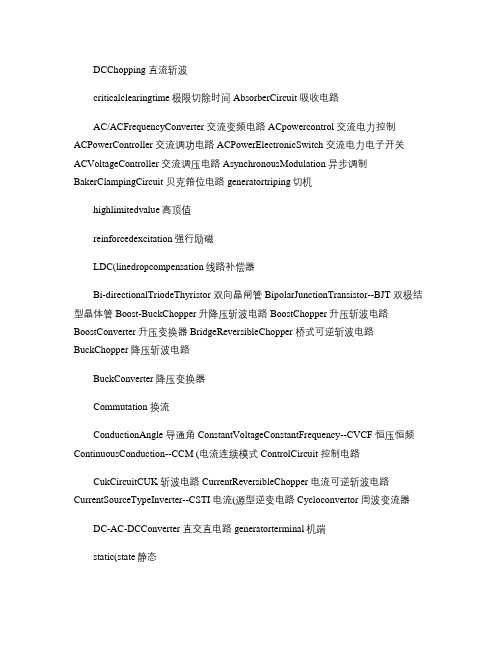
DCChopping 直流斩波criticalclearingtime极限切除时间AbsorberCircuit 吸收电路AC/ACFrequencyConverter 交流变频电路ACpowercontrol 交流电力控制ACPowerController 交流调功电路ACPowerElectronicSwitch 交流电力电子开关ACVoltageController 交流调压电路AsynchronousModulation 异步调制BakerClampingCircuit 贝克箝位电路generatortriping切机highlimitedvalue高顶值reinforcedexcitation强行励磁LDC(linedropcompensation线路补偿器Bi-directionalTriodeThyristor 双向晶闸管BipolarJunctionTransistor--BJT 双极结型晶体管Boost-BuckChopper 升降压斩波电路BoostChopper 升压斩波电路BoostConverter 升压变换器BridgeReversibleChopper 桥式可逆斩波电路BuckChopper 降压斩波电路BuckConverter 降压变换器Commutation 换流ConductionAngle 导通角ConstantVoltageConstantFrequency--CVCF 恒压恒频ContinuousConduction--CCM (电流连续模式ControlCircuit 控制电路CukCircuitCUK 斩波电路CurrentReversibleChopper 电流可逆斩波电路CurrentSourceTypeInverter--CSTI 电流(源型逆变电路Cycloconvertor 周波变流器DC-AC-DCConverter 直交直电路generatorterminal机端static(state静态dynamic(state动态onemachine-infinitybussystem单机无穷大系统AVR机端电压控制powerangle功角activepower有功(功率reactivepower无功(功率powerfactor功率因数reactivecurrent无功电流droopcharacteristics下降特性slope斜率rating额定ratio变比referencevalue参考值resistance电阻resistor电阻器impedance阻抗positivesequenceimpedance正序阻抗negativesequenceimpedance 负序阻抗zerosequenceimpedance零序阻抗capacitance电容;容抗capacitor(condenser电容器capacity容量shuntcapacitor并联电容器inductance电感;感抗inductor电感器reactance电抗reactor电抗器conductance电导susceptance电纳admittance导纳forwardconverter 正激电路frequencyconverter 变频器fullbridgeconverter 全桥电路fullbridgerectifier 全桥整流电路fullwaverectifier 全波整流电路fundamentalfactor 基波因数gateturn-offthyristor——GTO 可关断晶闸管generalpurposediode 普通二极管gianttransistor——GTR电力晶体管halfbridgeconverter 半桥电路hardswitching 硬开关highvoltageIC 高压集成电路hysteresiscomparison 带环比较方式PT电压互感器tap分接头drooprate下降率simulationanalysis仿真分析transferfunction传递函数blockdiagram框图receive-side受端margin裕度synchronization同步lossofsynchronization失去同步damping阻尼swing摇摆circuitbreaker保护断路器current电流AC(alternatingcurrent交流DC(directcurrent直流voltage电压indirectcurrentcontrol 间接电流控制indirectDC-DCconverter直接电流变换电路insulated-gatebipolartransistor---IGBT绝缘栅双极晶体管intelligentpowermodule---IPM智能功率模块integratedgate-commutatedthyristor---IGCT集成门极换流晶闸管inversion逆变latchingeffect擎住效应leakageinductance漏感lighttriggeredthyristo---LTT光控晶闸管linecommutation电网换流loadcommutation负载换流loopcurrent环流DCChoppingCircuit 直流斩波电路DC-DCConverter 直流-直流变换器DeviceCommutation 器件换流DirectCurrentControl 直接电流控制DiscontinuousConductionmode (电流断续模式 displacementfactor 位移因数distortionpower 畸变功率 doubleendconverter 双端电路 drivingcircuit 驱动电路electricalisolation 电气隔离 fastactingfuse 快速熔断器 fastrecoverydiode 快恢复二极管 fastrevcoveryepitaxialdiodes 快恢复外延二极管 fastswitchingthyristor 快速晶闸管fieldcontrolledthyristor 场控晶闸管 flybackconverter 反激电流 forcedcommutation 强迫换流 three-columntransformerThrClnTrans 三绕组变压器 double-columntransformerDblClmnTrans 双绕组变压器 Busbar 母线 TransmissionLine 输电线powerplant 发电厂 Breaker 断路器 Isolator 刀闸(隔离开关 tap 分接头 motor 电动机activepower 有功 reactivepower 无功 tapposition 档位 reactiveloss 有功损耗activeloss 无功损耗 power-factor 功率因数 power 功率 power-angle 功角 voltagegrade 电压等级 no-loadloss 空载损耗 ironloss 铁损 copperloss 铜损 no-loadcurrent 空载电流reactiveload/QLoad 无功负载 activeloadPLoad 有功负载。
功率半导体器件

功率半导体器件“power semiconductor device”和“power integrated circuit(简写为power IC或PIC)”直译就是功率半导体器件和功率集成电路。
在国际上与该技术领域对应的最权威的学术会议就叫做International Symposium on Power Semiconductor Devices and ICs,即功率半导体器件和功率集成电路国际会议。
“power”这个词可译为动力、能源、功率等,而在中文里这些词的含义不是完全相同的。
由于行业的动态发展,“power”的翻译发生了变化。
从上世纪六七十年代至八十年代初,功率半导体器件主要是可控硅整流器(SCR)、巨型晶体管(GTR)和其后的栅关断晶闸管(GTO)等。
它们的主要用途是用于高压输电,以及制造将电网的380V或220V交流电变为各种各样直流电的中大型电源和控制电动机运行的电机调速装置等,这些设备几乎都是与电网相关的强电装置。
因此,当时我国把这些器件的总称———power semiconductor devices没有直译为功率半导体器件,而是译为电力电子器件,并将应用这些器件的电路技术power electronics没有译为功率电子学,而是译为电力电子技术。
与此同时,与这些器件相应的技术学会为中国电工技术学会所属的电力电子分会,而中国电子学会并没有与之相应的分学会;其制造和应用的行业归口也划归到原第一机械工业部和其后的机械部,这些都是顺理成章的。
实际上从直译看,国外并无与电力电子相对应的专业名词,即使日本的“电力”与中文的“电力”也是字型相同而含义有别。
此外,当时用普通晶体管集成的小型电源电路———功率集成电路,并不归属于电力电子行业,而是和其他集成电路一起归口到原第四机械工业部和后来的电子工业部。
20世纪80年代以后,功率半导体行业发生了翻天覆地的变化。
功率半导体器件变为以功率金属氧化物半导体场效应晶体管(功率MOSFET,常简写为功率MOS)、绝缘栅双极晶体管(IGBT)以及功率集成电路(power IC,常简写为PIC)为主。
“电力电子技术”双语教学的实践与分析

章为绪论 ( 原文 版第一、二章 ) 、第二章为 电力电子器件 ( 原
有核心课程性 质的较为重要 的专业基础课 。本课程工程实践性 文版第二十~第二十五章 ) 、第 三章 为不可控 整流 电路 ( 原文版 较强 ,其应用 已渗透 到工业生产和社会生活的各 个领域。在本 第五章 ) 、第 四章为可控整流电路及其逆变工作状 态 ( 原文版第
真 的教 学 模 式引入 课 堂 教 学 。
考试形式采用闭卷 考试,中英文题 目的分 值各 占 5 %,采 0
出卷形式和考试方式。
用同场 A、B卷分 卷考试 ,这是在本次双语教学 中首次尝试的 析与试 验比较相 结合。学 生的作业和实验报告 也是围绕这 两点 二 教学 内容的组织
首先是教材的选择。我们选择的教材是 { o r Ee to is ( we lcrnc P
课程 中使 用双语教学 ,是提高教学量、更好地培养高水平工 六章) 、第五章 为斩波电路 ( 原文版第七章) 、第六章为逆 变电 程技术人 才的一个有 效手段 。
一
路 ( 原文版第八章) 、第七章为电力电子技术的控制技术 ( 原文 版第九章) ,第八章为电力电子技术的应用 ( 原文版第十章) 。 此外,为提高课程教学的实践性和配合 学校提 出的研 究性
教 学 要求 ,在每 章 教 学 结 束后 ,都 提 出了相 关 的 设 计 性 小 课题 ,
.
本课程双语教学体系的设计
为适应本课程双语教学 的特殊性 ,我们在其教学体系上作
了较 大 调 整 。
首先是重新编 写了教学大纲。在 编写教学 大纲时,充分考 作为课后练习或在课程设计环节中研究 。 虑了所选教材的具体 内容。例如,原文版教材中采用了较多的仿 真波 形和 实际波形,我们就在教学 大纲中提出仿真 软件 的学 习 三.教学过程的实施
自动化专业英语-2003-1
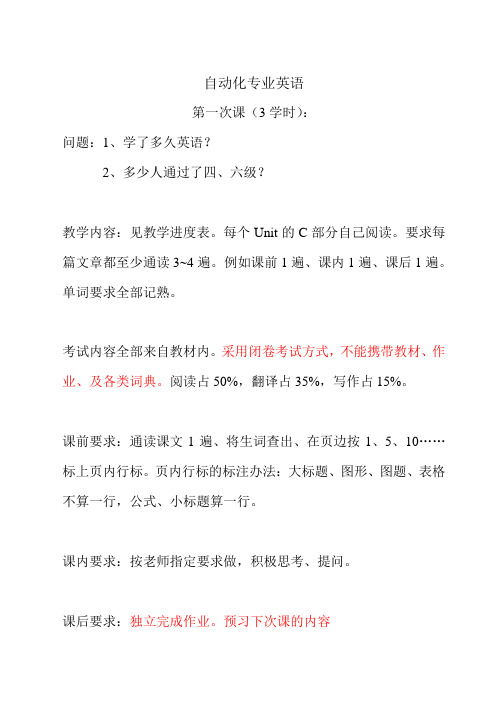
自动化专业英语第一次课(3学时):问题:1、学了多久英语?2、多少人通过了四、六级?教学内容:见教学进度表。
每个Unit的C部分自己阅读。
要求每篇文章都至少通读3~4遍。
例如课前1遍、课内1遍、课后1遍。
单词要求全部记熟。
考试内容全部来自教材内。
采用闭卷考试方式,不能携带教材、作业、及各类词典。
阅读占50%,翻译占35%,写作占15%。
课前要求:通读课文1遍、将生词查出、在页边按1、5、10……标上页内行标。
页内行标的标注办法:大标题、图形、图题、表格不算一行,公式、小标题算一行。
课内要求:按老师指定要求做,积极思考、提问。
课后要求:独立完成作业。
预习下次课的内容成绩计算办法:平时成绩30%,期终考试成绩70%。
平时成绩由作业决定,缺交作业、或者作业抄袭者(包括将作业给别人抄袭者)记为0分。
作业不整洁者最多得10分。
作业必须按时完成,必须在上课前交作业!!迟到者不收!请假者,请通过他人交作业。
养成良好的阅读习惯。
阅读是一种重要的技能,良好的阅读习惯是可以培养的。
几种阅读方法:Skimming:浏览或者略读。
只需要理解文章内容的大约50%,快速地获取中心意思和重点。
速度为300~1000WPM。
关键是掌握英文的写作特点。
将重点放在句首和句尾的主题句上。
注意抓住关键词。
Scanning:浏览或者查阅。
查阅只需要从文章中有目的地迅速查找某一具体事实或者特定信息。
Fast reading:快速阅读。
速度为200~350 wpm。
要求基本上理解文章内容。
为了养成快速阅读的习惯,注意在阅读时不要发出声音;不要用铅笔、手指等在文字下移动;不要在自己不懂的单词旁标注中文;不要中断阅读去查生词;不要逐字逐字地读。
要从逐字逐字地读逐步改为按意群来读。
精读:在阅读的同时对文章从各方面(包括语法、词汇、写作特点和中心思想)进行分析。
要注意培养自己的中文阅读能力。
要丰富自己的知识结构。
要提高自己的词汇量。
而所有这一切又都是要在阅读实践中来完成的。
电力专业英语阅读与翻译
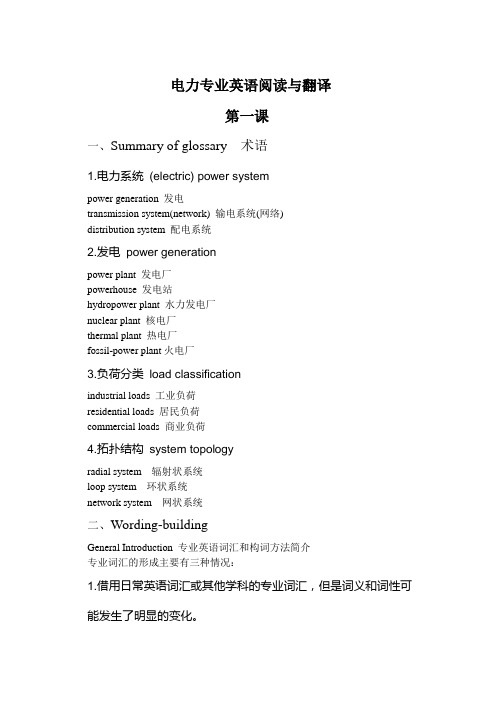
电力专业英语阅读与翻译第一课一、Summary of glossary 术语1.电力系统(electric) power systempower generation 发电transmission system(network) 输电系统(网络)distribution system 配电系统2.发电power generationpower plant 发电厂powerhouse 发电站hydropower plant 水力发电厂nuclear plant 核电厂thermal plant 热电厂fossil-power plant火电厂3.负荷分类load classificationindustrial loads 工业负荷residential loads 居民负荷commercial loads 商业负荷4.拓扑结构system topologyradial system 辐射状系统loop system 环状系统network system 网状系统二、Wording-buildingGeneral Introduction 专业英语词汇和构词方法简介专业词汇的形成主要有三种情况:1.借用日常英语词汇或其他学科的专业词汇,但是词义和词性可能发生了明显的变化。
例如:在日常英语中表示“力量、权力”和在机械专业表示“动力”的power,数学上表示“幂”,在电力专业领域可以仍作为名词,表示“电力、功率、电能”;也可以作为动词,表示“供以电能”。
在日常英语中表示“植物”的plant,在电力专业领域中用来表示“电厂”等。
2.由日常英语词汇或其他学科的专业词汇,直接合成新的词汇。
例如:over和head组合成overhead,表示“架空(输电线)”;super和conductor 合成superconductor,表示“超导体”等。
3.由基本词根和前缀或后缀组成新的词汇。
大部分专业词汇属于这种情况。
外文翻译—电力电子技术(英文+译文)
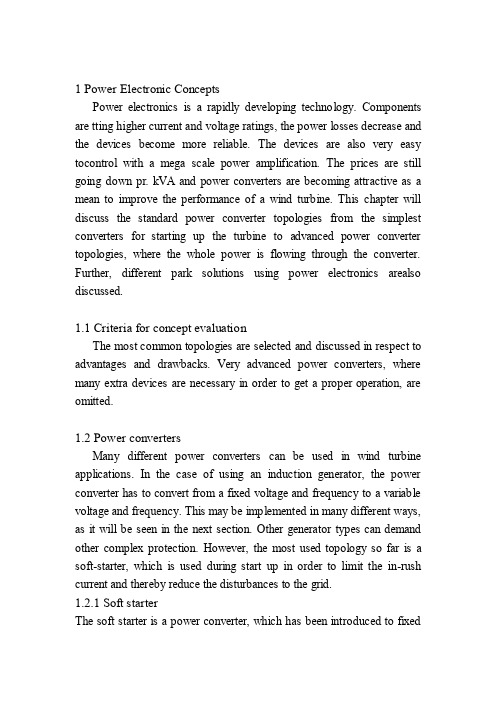
1 Power Electronic ConceptsPower electronics is a rapidly developing technology. Components are tting higher current and voltage ratings, the power losses decrease and the devices become more reliable. The devices are also very easy tocontrol with a mega scale power amplification. The prices are still going down pr. kVA and power converters are becoming attractive as a mean to improve the performance of a wind turbine. This chapter will discuss the standard power converter topologies from the simplest converters for starting up the turbine to advanced power converter topologies, where the whole power is flowing through the converter. Further, different park solutions using power electronics arealso discussed.1.1 Criteria for concept evaluationThe most common topologies are selected and discussed in respect to advantages and drawbacks. Very advanced power converters, where many extra devices are necessary in order to get a proper operation, are omitted.1.2 Power convertersMany different power converters can be used in wind turbine applications. In the case of using an induction generator, the power converter has to convert from a fixed voltage and frequency to a variable voltage and frequency. This may be implemented in many different ways, as it will be seen in the next section. Other generator types can demand other complex protection. However, the most used topology so far is a soft-starter, which is used during start up in order to limit the in-rush current and thereby reduce the disturbances to the grid.1.2.1 Soft starterThe soft starter is a power converter, which has been introduced to fixedspeed wind turbines to reduce the transient current during connection or disconnection of the generator to the grid. When the generator speed exceeds the synchronous speed, the soft-starter is connected. Using firing angle control of the thyristors in the soft starter the generator is smoothly connected to the grid over a predefined number of grid periods. An example of connection diagram for the softstarter with a generator is presented in Figure1.Figure 1. Connection diagram of soft starter with generators.The commutating devices are two thyristors for each phase. These are connected in anti-parallel. The relationship between the firing angle (﹤) and the resulting amplification of the soft starter is non-linear and depends additionally on the power factor of the connected element. In the case of a resistive load, may vary between 0 (full on) and 90 (full off) degrees, in the case of a purely inductive load between 90 (full on) and 180 (full off) degrees. For any power factor between 0 and 90 degrees, w ill be somewhere between the limits sketched in Figure 2.Figure 2. Control characteristic for a fully controlled soft starter.When the generator is completely connected to the grid a contactor (Kbyp) bypass the soft-starter in order to reduce the losses during normal operation. The soft-starter is very cheap and it is a standard converter in many wind turbines.1.2.2 Capacitor bankFor the power factor compensation of the reactive power in the generator, AC capacitor banks are used, as shown in Figure 3. The generators are normally compensated into whole power range. The switching of capacitors is done as a function of the average value of measured reactive power during a certain period.Figure 3. Capacitor bank configuration for power factor compensation ina wind turbine.The capacitor banks are usually mounted in the bottom of the tower or in thenacelle. In order to reduce the current at connection/disconnection of capacitors a coil (L) can be connected in series. The capacitors may be heavy loaded and damaged in the case of over-voltages to the grid and thereby they may increase the maintenance cost.1.2.3 Diode rectifierThe diode rectifier is the most common used topology in power electronic applications. For a three-phase system it consists of six diodes. It is shown in Figure 4.Figure 4. Diode rectifier for three-phase ac/dc conversionThe diode rectifier can only be used in one quadrant, it is simple and it is notpossible to control it. It could be used in some applications with a dc-bus.1.2.4 The back-to-back PWM-VSIThe back-to-back PWM-VSI is a bi-directional power converter consisting of two conventional PWM-VSI. The topology is shown in Figure 5.To achieve full control of the grid current, the DC-link voltage must be boosted to a level higher than the amplitude of the grid line-line voltage. The power flow of the grid side converter is controlled in orderto keep the DC-link voltage constant, while the control of the generator side is set to suit the magnetization demand and the reference speed. The control of the back-to-back PWM-VSI in the wind turbine application is described in several papers (Bogalecka, 1993), (Knowles-Spittle et al., 1998), (Pena et al., 1996), (Yifan & Longya, 1992), (Yifan & Longya, 1995).Figure 5. The back-to-back PWM-VSI converter topology.1.2.4.1 Advantages related to the use of the back-to-back PWM-VSIThe PWM-VSI is the most frequently used three-phase frequency converter. As a consequence of this, the knowledge available in the field is extensive and well established. The literature and the available documentation exceed that for any of the other converters considered in this survey. Furthermore, many manufacturers produce components especially designed for use in this type of converter (e.g., a transistor-pack comprising six bridge coupled transistors and anti paralleled diodes). Due to this, the component costs can be low compared to converters requiring components designed for a niche production.A technical advantage of the PWM-VSI is the capacitor decoupling between the grid inverter and the generator inverter. Besides affording some protection, this decoupling offers separate control of the two inverters, allowing compensation of asymmetry both on the generator side and on the grid side, independently.The inclusion of a boost inductance in the DC-link circuit increases the component count, but a positive effect is that the boost inductance reduces the demands on the performance of the grid side harmonic filter, and offers some protection of the converter against abnormal conditions on the grid.1.2.4.2 Disadvantages of applying the back-to-back PWM-VSIThis section highlights some of the reported disadvantages of the back-to-back PWM-VSI which justify the search for a more suitable alternative converter:In several papers concerning adjustable speed drives, the presence of the DC link capacitor is mentioned as a drawback, since it is heavy and bulky, it increases the costs and maybe of most importance, - it reduces the overall lifetime of the system. (Wen-Song & Ying-Yu, 1998); (Kim & Sul, 1993); (Siyoung Kim et al., 1998).Another important drawback of the back-to-back PWM-VSI is the switching losses. Every commutation in both the grid inverter and the generator inverter between the upper and lower DC-link branch is associated with a hard switching and a natural commutation. Since the back-to-back PWM-VSI consists of two inverters, the switching losses might be even more pronounced. The high switching speed to the grid may also require extra EMI-filters.To prevent high stresses on the generator insulation and to avoid bearing current problems (Salo & Tuusa, 1999), the voltage gradient may have to be limited by applying an output filter.1.2.5 Tandem converterThe tandem converter is quite a new topology and a few papers only have treated it up till now ((Marques & Verdelho, 1998); (Trzynadlowski et al., 1998a); (Trzynadlowski et al., 1998b)). However, the idea behind the converter is similar to those presented in ((Zhang et al., 1998b)), where the PWM-VSI is used as an active harmonic filter to compensate harmonic distortion. The topology of the tandem converter is shown inFigure 6.Figure 6. The tandem converter topology used in an induction generator wind turbine system.The tandem converter consists of a current source converter, CSC, in thefollowing designated the primary converter, and a back-to-back PWM-VSI, designated the secondary converter. Since the tandem converter consists of four controllable inverters, several degrees of freedom exist which enable sinusoidal input and sinusoidal output currents. However, in this context it is believed that the most advantageous control of the inverters is to control the primary converter to operate in square-wave current mode. Here, the switches in the CSC are turned on and off only once per fundamental period of the input- and output current respectively. In square wave current mode, the switches in the primary converter may either be GTO.s, or a series connection of an IGBT and a diode.Unlike the primary converter, the secondary converter has to operateat a high switching frequency, but the switched current is only a small fraction of the total load current. Figure 7 illustrates the current waveform for the primary converter, the secondary converter, is, and the total load current il.In order to achieve full control of the current to/from the back-to-back PWMVSI, the DC-link voltage is boosted to a level above the grid voltage. As mentioned, the control of the tandem converter is treated in only a few papers. However, the independent control of the CSC and the back-to-back PWM-VSI are both well established, (Mutschler & Meinhardt, 1998); (Nikolic & Jeftenic, 1998); (Salo & Tuusa, 1997); (Salo & Tuusa, 1999).Figure 7. Current waveform for the primary converter, ip, the secondary converter, is, and the total load current il.1.2.5.1Advantages in the use of the Tandem ConverterThe investigation of new converter topologies is commonly justifiedby thesearch for higher converter efficiency. Advantages of the tandem converter are the low switching frequency of the primary converter, and the low level of the switched current in the secondary converter. It is stated that the switching losses of a tandem inverter may be reduced by 70%, (Trzynadlowski et al., 1998a) in comparison with those of an equivalent VSI, and even though the conduction losses are higher for the tandem converter, the overall converter efficiency may be increased.Compared to the CSI, the voltage across the terminals of the tandem converter contains no voltage spikes since the DC-link capacitor of the secondary converter is always connected between each pair of input- and output lines (Trzynadlowski et al., 1998b).Concerning the dynamic properties, (Trzynadlowski et al., 1998a) states that the overall performance of the tandem converter is superior to both the CSC and the VSI. This is because current magnitude commands are handled by the voltage source converter, while phase-shift current commands are handled by the current source converter (Zhang et al., 1998b).Besides the main function, which is to compensate the current distortion introduced by the primary converter, the secondary converter may also act like an active resistor, providing damping of the primary inverter in light load conditions (Zhang et al., 1998b).1.2.5.2 Disadvantages of using the Tandem ConverterAn inherent obstacle to applying the tandem converter is the high number of components and sensors required. This increases the costs and complexity of both hardware and software. The complexity is justified by the redundancy of the system (Trzynadlowski et al., 1998a), however the system is only truly redundant if a reduction in power capability and performance is acceptable.Since the voltage across the generator terminals is set by the secondary inverter, the voltage stresses at the converter are high.Therefore the demands on the output filter are comparable to those when applying the back-to-back PWM-VSI.In the system shown in Figure 38, a problem for the tandem converter in comparison with the back-to-back PWM-VSI is the reduced generator voltage. By applying the CSI as the primary converter, only 0.866% of the grid voltage can be utilized. This means that the generator currents (and also the current through the switches) for the tandem converter must be higher in order to achieve the same power.1.2.6 Matrix converterIdeally, the matrix converter should be an all silicon solution with no passive components in the power circuit. The ideal conventional matrix converter topology is shown in Figure 8.Figure 8. The conventional matrix converter topology.The basic idea of the matrix converter is that a desired input current (to/from the supply), a desired output voltage and a desired output frequency may be obtained by properly connecting the output terminals of the converter to the input terminals of the converter. In order to protect the converter, the following two control rules must be complied with: Two (or three) switches in an output leg are never allowed to be on at the same time. All of the three output phases must be connected to an input phase at any instant of time. The actual combination of the switchesdepends on the modulation strategy.1.2.6.1 Advantages of using the Matrix ConverterThis section summarises some of the advantages of using the matrix converter in the control of an induction wind turbine generator. For a low output frequency of the converter the thermal stresses of the semiconductors in a conventional inverter are higher than those in a matrix converter. This arises from the fact that the semiconductors in a matrix converter are equally stressed, at least during every period of the grid voltage, while the period for the conventional inverter equals the output frequency. This reduces thethermal design problems for the matrix converter.Although the matrix converter includes six additional power switches compared to the back-to-back PWM-VSI, the absence of the DC-link capacitor may increase the efficiency and the lifetime for the converter (Schuster, 1998). Depending on the realization of the bi-directional switches, the switching losses of the matrix inverter may be less than those of the PWM-VSI, because the half of the switchings become natural commutations (soft switchings) (Wheeler & Grant, 1993).1.2.6.2 Disadvantages and problems of the matrix converterA disadvantage of the matrix converter is the intrinsic limitation of the output voltage. Without entering the over-modulation range, the maximum output voltage of the matrix converter is 0.866 times the input voltage. To achieve the same output power as the back-to-back PWM-VSI, the output current of the matrix converter has to be 1.15 times higher, giving rise to higher conducting losses in the converter (Wheeler & Grant, 1993).In many of the papers concerning the matrix converter, the unavailability of a true bi-directional switch is mentioned as one of the major obstacles for the propagation of the matrix converter. In the literature, three proposals for realizing a bi-directional switch exists. The diode embedded switch (Neft & Schauder, 1988) which acts like a truebi-directional switch, the common emitter switch and the common collector switch (Beasant et al., 1989).Since real switches do not have infinitesimal switching times (which is not desirable either) the commutation between two input phases constitutes a contradiction between the two basic control rules of the matrix converter. In the literature at least six different commutation strategies are reported, (Beasant et al., 1990); (Burany, 1989); (Jung & Gyu, 1991); (Hey et al., 1995); (Kwon et al., 1998); (Neft & Schauder, 1988). The most simple of the commutation strategies are those reported in (Beasant et al., 1990) and (Neft & Schauder, 1988), but neither of these strategies complies with the basic control rules.译文1 电力电子技术的内容电力电子技术是一门正在快速发展的技术,电力电子元器件有很高的额定电流和额定电压,它的功率减小元件变得更加可靠、耐用.这种元件还可以用来控制比它功率大很多倍的元件。
新能源汽车电力电子技术 习题
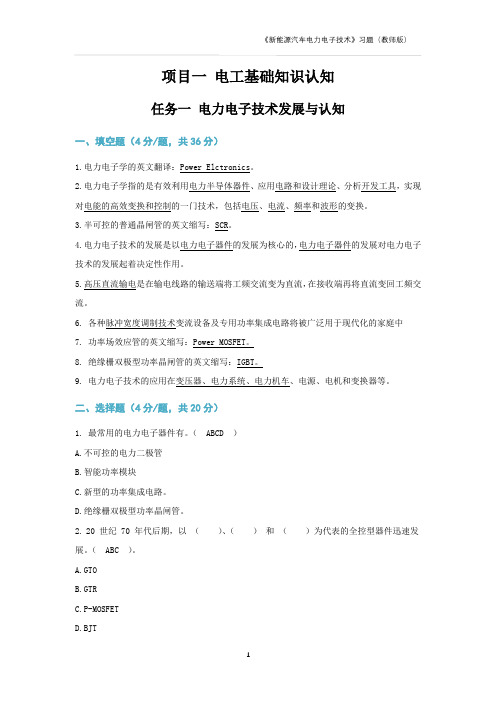
项目一电工基础知识认知任务一电力电子技术发展与认知一、填空题(4分/题,共36分)1.电力电子学的英文翻译:Power Elctronics。
2.电力电子学指的是有效利用电力半导体器件、应用电路和设计理论、分析开发工具,实现对电能的高效变换和控制的一门技术,包括电压、电流、频率和波形的变换。
3.半可控的普通晶闸管的英文缩写:SCR。
4.电力电子技术的发展是以电力电子器件的发展为核心的,电力电子器件的发展对电力电子技术的发展起着决定性作用。
5.高压直流输电是在输电线路的输送端将工频交流变为直流,在接收端再将直流变回工频交流。
6.各种脉冲宽度调制技术变流设备及专用功率集成电路将被广泛用于现代化的家庭中7.功率场效应管的英文缩写:Power MOSFET。
8.绝缘栅双极型功率晶闸管的英文缩写:IGBT。
9.电力电子技术的应用在变压器、电力系统、电力机车、电源、电机和变换器等。
二、选择题(4分/题,共20分)1.最常用的电力电子器件有。
( ABCD )A.不可控的电力二极管B.智能功率模块C.新型的功率集成电路。
D.绝缘栅双极型功率晶闸管。
2.20 世纪 70 年代后期,以()、()和()为代表的全控型器件迅速发展。
( ABC )。
A.GTOB.GTRC.P-MOSFETD.BJT3.20世纪80年代以()为代表的复合型器件异军突起。
( D )A.GTOB.GTRC.P-MOSFETD.IGBT4.电力电子技术应用在以下( ABCD )电源中。
A.电解电源B.电镀电源C.开关电源D.航空电源及通信电源5.以下哪些属于新能源技术应应用( ABCD )A.风力发电B.光伏发电C.光热发电D.生物质能三、判断题(4分/题,共24分)1.有源滤波器可以解决针对日益严重的电网谐波“公害”,人们采用电力电子技术找到了解决的途径。
(√)2.电力电子技术将渗透到航天、国防、工农业生产、交通、文教卫生、办公自动化乃至于家庭的各个角落。
电气工程专业英语(电力类)翻译
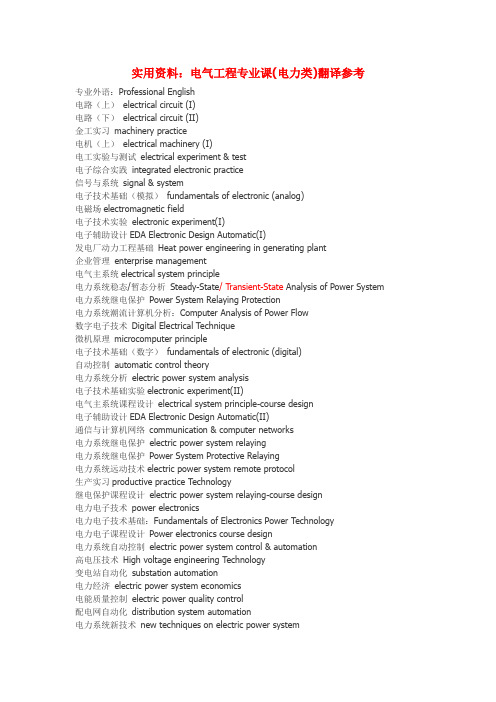
实用资料:电气工程专业课(电力类)翻译参考专业外语:Professional English电路(上)electrical circuit (I)电路(下)electrical circuit (II)金工实习machinery practice电机(上)electrical machinery (I)电工实验与测试electrical experiment & test电子综合实践integrated electronic practice信号与系统signal & system电子技术基础(模拟)fundamentals of electronic (analog)电磁场electromagnetic field电子技术实验electronic experiment(I)电子辅助设计EDA Electronic Design Automatic(I)发电厂动力工程基础Heat power engineering in generating plant企业管理enterprise management电气主系统electrical system principle电力系统稳态/暂态分析Steady-State/ Transient-State Analysis of Power System 电力系统继电保护Power System Relaying Protection电力系统潮流计算机分析:Computer Analysis of Power Flow数字电子技术Digital Electrical Technique微机原理microcomputer principle电子技术基础(数字)fundamentals of electronic (digital)自动控制automatic control theory电力系统分析electric power system analysis电子技术基础实验electronic experiment(II)电气主系统课程设计electrical system principle-course design电子辅助设计EDA Electronic Design Automatic(II)通信与计算机网络communication & computer networks电力系统继电保护electric power system relaying电力系统继电保护Power System Protective Relaying电力系统远动技术electric power system remote protocol生产实习productive practice Technology继电保护课程设计electric power system relaying-course design电力电子技术power electronics电力电子技术基础:Fundamentals of Electronics Power Technology电力电子课程设计Power electronics course design电力系统自动控制electric power system control & automation高电压技术High voltage engineering Technology变电站自动化substation automation电力经济electric power system economics电能质量控制electric power quality control配电网自动化distribution system automation电力系统新技术new techniques on electric power system控制电机electrical machine control调度自动化与能量管理energy management & automation灵活交流输电系统flexible AC transmission system计算机保护computer protection电力系统电磁兼容EMC in electric power system毕业实习graduation practice毕业设计graduation dissertation数字信号处理:Digital Signal Processing自动控制理论:Automatic Control Theory电气工程基础:Fundamentals of Electrical Engineering电磁场概论:Introduction to Electro-Magnetic Field计算机继电保护:Microcomputer-Based Relaying Protection电气设备的绝缘检测与故障诊断:Insulation Diagnostics and Troubl-Shooting for Electrical Installations电网规划:Power System Planning可编程控制器原理及应用:Principles of PLC (Programmable logic Controller) And Application电磁场数值计算:Numerical Computation of Electro-Magnetic Field电力系统继电保护:Relay Protection of Power System电力系统自动装置原理The Principle of Electric Power System Automatic Equipment电力通信系统及调度自动化:Power System Communication and Dispatching Automatic专业方向电气工程Electrical Engineering电机与电器Electric Machines and Electric Apparatus电力系统及其自动化Power System and its Automation高电压与绝缘技术High Voltage and Insulation Technology电力电子与电力传动Power Electronics and Power Drives电工理论与新技术Theory and New Technology of Electrical Engineering电子科学与技术Electronics Science and Technology。
英文翻译英文文章
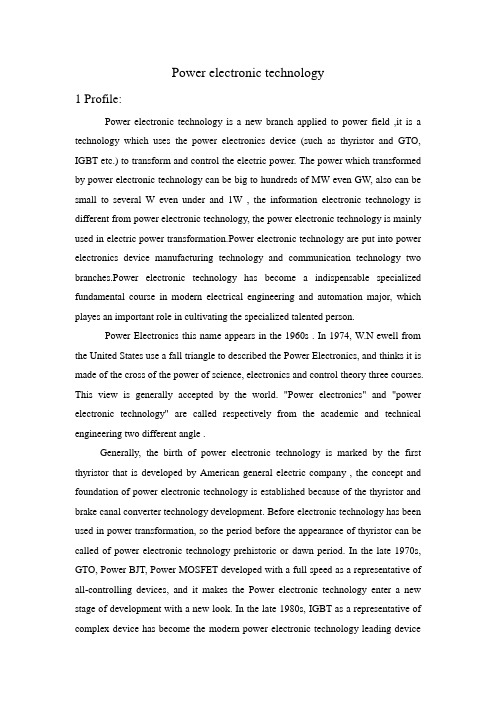
Power electronic technology1 Profile:Power electronic technology is a new branch applied to power field ,it is a technology which uses the power electronics device (such as thyristor and GTO, IGBT etc.) to transform and control the electric power. The power which transformed by power electronic technology can be big to hundreds of MW even GW, also can be small to several W even under and 1W , the information electronic technology is different from power electronic technology, the power electronic technology is mainly used in electric power transformation.Power electronic technology are put into power electronics device manufacturing technology and communication technology two branches.Power electronic technology has become a indispensable specialized fundamental course in modern electrical engineering and automation major, which playes an important role in cultivating the specialized talented person.Power Electronics this name appears in the 1960s . In 1974, W.N ewell from the United States use a fall triangle to described the Power Electronics, and thinks it is made of the cross of the power of science, electronics and control theory three courses. This view is generally accepted by the world. "Power electronics" and "power electronic technology" are called respectively from the academic and technical engineering two different angle .Generally, the birth of power electronic technology is marked by the first thyristor that is developed by American general electric company , the concept and foundation of power electronic technology is established because of the thyristor and brake canal converter technology development. Before electronic technology has been used in power transformation, so the period before the appearance of thyristor can be called of power electronic technology prehistoric or dawn period. In the late 1970s, GTO, Power BJT, Power MOSFET developed with a full speed as a representative of all-controlling devices, and it makes the Power electronic technology enter a new stage of development with a new look. In the late 1980s, IGBT as a representative of complex device has become the modern power electronic technology leading devicebecause of its small drive power, high switching speed, low pressure drop, big flow capacity and superior performance. In order to make power electronics device have compact structure and small volume, we often make several power electronic devices and necessary auxiliary devices into modle form, then integrate the driver, control, protection circuit and power devices together to constitute a power integrated circuit (PIC). At present the power of PIC are still small, but it represents an important direction of the power electronic technology development.It is sometimes also called power electronic technology to realize the implements industrial scale power transformation through using power electronics device. Normally, it converts a form of industrial electrical energy into another form of industrial electrical energy. For example, it will transform AC power into DC power or can transform DC power into AC power; It will transform industrial frequency power into the power whose equipment has needed frequency ; When normal AC power is interrupted, we can transform the DC power of battery into industrial frequency AC power through inverter. Application power electronic technology also can realize the conversion between electricity and nonelectricity. For example, it can use the Solar cell to convert Solar radiation to electricity. What is different from electronic technology is that the electrical energy transformed by power electronic technology is as energy rather than as a carrier of information sensor. So many people are concerned about the electrical power converted .2 Application:General industrial:AC/DCmotor, electrochemical industry, metallurgy industryTransportation:Electrified railways, electric vehicles, aviation and navigationPower system:HVDC transmission, flexible ac power, reactive power compensationElectronic devices power:Provide motivation for information electronic technologyHousehold appliances:Energy-saving lamps, frequency conversion air conditioningOther:UPS, shuttle engineer, new energy, power generation device3 Effect:(1) Optimizing the use of electricity:the electricity is used reasonably, efficiently and economically through the power electronic technology processing the electric power,and realize the optimum power use. For example, in electricity saving aspects, in view of the investigation of fan water pump, electric traction, mill smelting, light industry papermaking, industrial furnace, induction heating,electric welding, chemical, electrolytic 14 aspects, potential power saving is equivalent of sixteen percent of 1990 total capacity, so the promotion and application of power electronic technology is a strategic energy saving measures, normally the effect about energy saving can reach ten percent to forty percent, our country has many device listed the Popularized project in energy saving.(2) Transforming the traditional industries and developing the new industries such as electromechanical integration . According to the prediction from developed countries, about 95 percent electricity will be used again after the dealing by power electronic technology. Power electronic technology is the media of light current controling strong electricity,and it is specialized in the important interface between the electromechanical equipment and computers, it creates conditions for the traditional industries and emerging industry adopting micro-electronic technology ,and it becomes the guarantee and foundation in computer’s effection.(3) The development of power electronic technology’s high frequencyand and frequency conversion technology will make electrical equipment power develop from low frequency to high frequency through breaking industrial frequency tradition. To achieve the best work efficiency, the volume of electrical and mechanical equipment will be reduced several times even a few times,and its response speed also will be improved, and it can adapt to any high bench mark signals, realize noiseless and hasnew functions and applications.(4) To a certain extent,the intelligence progress of power electronic takes information processing and power handling together, and make microelectronics technology and power electronic technology integration, its development is likely to cause significant reform of the electronic technology. Some even suggest that the next item on the revolution about electronics will take place in the electronic technology application area which based on industrial equipment and electric grid , power electronic technology will bring people to the edge of the second electronic revolution.4 Device:The first glass mercury arc rectifier appeared in 2002. In 1910 iron shell mercury arc rectifier appeared. With mercury arc rectifier instead of mechanical switch and change flow sensor, this is an inchoation of power electronic technology. the copper oxide rectifier trial is made in 1920, in 1923 selenium rectifier appeared. In the 1930s, these rectifier were used in electric power rectifier devices widely. At the end of 1940s transistors appeared. In the beginning of 1950s, transistors developed to the high power, at the same time, high-power diodes made by the semiconductor crystal material also got developed. In 1954, the ASEA company firstly applied mercury arc tube to high voltage rectifying and inverter and 100 kv DC on the transmission, transmissing 20 megawatts power. In 1956, Americans Moore j. made thyristor prototype. In 1957, Americans practical R.A. york made practical thyristor. At the end of the 1950s thyristor were used in power electronic devices, since the 1960s, it was rapidly promoted,and it developed a series of derived devices ,and it also expanded the power electronic technology applications. Power electronic circuits develop many power electronic circuits with thyristor application promoted, according to the function,it can be divided into: (1) the rectifier circuit which can exchang AC power to DC power; (2) the inverter circuits which can exchang DC power to AC power;(3)the transform circuit witch exchange a form of AC electric power into another form of AC electric power; (4) the DC transform circuit which can exchange a form of DCpower to another form of DC power. These circuits include thyristor and each thyristor needs corresponding flip-flop. Then many trigger control circuits appear for cooperating with these power electronic circuit . According to the device used, these control circuits may generally be divided into three generations. The first generation control circuit mainly made of the separate electronic components (such as transistors, diodes). Until the late 1980s,it still be used too much. The second generation is made of the integrated circuit. Since 1958, the first integrated circuit appeared in America, it had a rapid development. It was used to control circuit in power electronic device, made its structure compact and its function and reliability be improved .The third generation were controlled by microcomputer. Since the 1970s, due to the development of the microcomputer, the power electronics improved toward realizing its intelligence. Many kinds of power electronics devices which are made of thyristor appeared constantly with power electronic circuits developing and completing.Such as Electrolytic power,welding power, DC power used for electroplating; DC and AC traction, DC transmission etc power use for transmission. Power electronics device can adjust frequency and voltage easily, it has fast response, much function and a high degree of automation. so it can not only save energy , and can often increase productivity and the quality of products, save raw material, and often can improve the working environment. But most power electronic devices are electronic switch type device, it ofen produce harmonic generation interference to power and load, sometimes it causes certain high frequency interference,on the surrounding environment this must be properly solved when design these devices and systems.5 Progress:Ranging from the 1950s to the 1970s,the power electronic technology based on high-power silicon diode and thyristor (especially thyristor) developed maturely. Since the 1970s, two aspects of power electronic technology development caused a huge impact. Firstly, the development of microcomputer control system plays an important role in the power electronic devices, fault detection, information processing;Secondly, microelectronics technology, optical fiber technology are widely used in power electronics device, and develops more new generation of power electronic devices. One besides common thyristors develop towards to more large capacity, the voltage of GTO has reached 4500 volts, current has reached 25 ~ 3000 Ann; A bipolar transistor also towards greater capacity development, the highest volt of industrial products in late 1980s can reach 1,400 volts.maximum current can reach 40 Ann, working frequency is much higher than thyristor. Along with the development of the optical fiber technology, the United States and Japan had developed light-activated thyristor and used it for HVDC system from 1981 to 1982 years. It improvs insulation level and the anti-interference ability, can make the variable flow equipment to small, lightweight direction develop, both reduce the cost and improve operating reliability.a new generation of power electronic devices made of field control and bipolar type synthesis, such as IGBT and MOS control thyristor is also arising, capacity is quite large. These new devices have door shutoff ability, and can improve the working frequency ,it will make power electronic circuits simple, make the power electronic devices improve on volume, weight, efficiency, performance and so on . At the same time ,the computer modeling and simulation technology of power electronic devices, power electronic circuits and power electronics also develop constantly.。
自动化专业英语重点单词
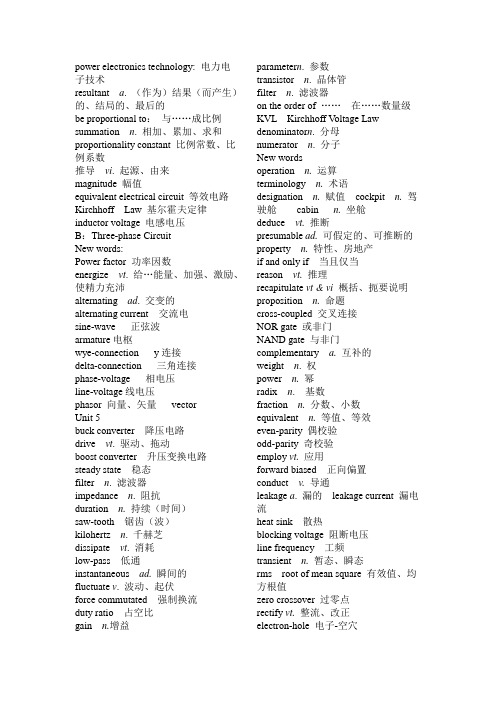
power electronics technology: 电力电子技术resultant a. (作为)结果(而产生)的、结局的、最后的be proportional to:与……成比例summation n. 相加、累加、求和proportionality constant 比例常数、比例系数推导vi. 起源、由来magnitude 幅值equivalent electrical circuit 等效电路Kirchhoff Law 基尔霍夫定律inductor voltage 电感电压B:Three-phase CircuitNew words:Power factor 功率因数energize vt. 给…能量、加强、激励、使精力充沛alternating ad. 交变的alternating current 交流电sine-wave 正弦波armature电枢wye-connection y连接delta-connection 三角连接phase-voltage 相电压line-voltage线电压phasor 向量、矢量vectorUnit 5buck converter 降压电路drive vt. 驱动、拖动boost converter 升压变换电路steady state 稳态filter n. 滤波器impedance n. 阻抗duration n.持续(时间)saw-tooth 锯齿(波)kilohertz n. 千赫芝dissipate vt. 消耗low-pass 低通instantaneous ad.瞬间的fluctuate v. 波动、起伏force commutated 强制换流duty ratio 占空比gain n.增益parameter n. 参数transistor n. 晶体管filter n. 滤波器on the order of ……在……数量级KVL Kirchhoff V oltage Law denominator n. 分母numerator n. 分子New wordsoperation n.运算terminology n. 术语designation n.赋值cockpit n.驾驶舱cabin n.坐舱deduce vt.推断presumable ad.可假定的、可推断的property n.特性、房地产if and only if 当且仅当reason vt.推理recapitulate vt & vi概括、扼要说明proposition n.命题cross-coupled 交叉连接NOR gate 或非门NAND gate 与非门complementary a.互补的weight n. 权power n.幂radix n. 基数fraction n.分数、小数equivalent n. 等值、等效even-parity 偶校验odd-parity 奇校验employ vt.应用forward biased 正向偏置conduct v.导通leakage a. 漏的leakage current 漏电流heat sink 散热blocking voltage 阻断电压line frequency 工频transient n.暂态、瞬态rms root of mean square 有效值、均方根值zero crossover 过零点rectify vt.整流、改正electron-hole 电子-空穴sinusoidal a.正弦的kinetic energy 动能power flow 功率流regenerative braking 再生制动cancellation n.补偿utility grid 公用电网block diagram 方框图lag v滞后quadrant n. 象限Uninterruptible power supplies (UPS) 不停电电源utility grid 公用电网malfunction n. 故障line frequency 工频substantial a.基本的、本质的cosine n. 余弦distortion n. 畸形、畸变resonance n. 谐振utility relay 继电保护notch n. 缺口proliferation n. 扩大、扩散electromagnetic interference 电磁干扰unipolar a. 单极性的unidirectional a. 单方向的mal 前缀malnutrition 营养不良malformation 畸形maladministration 管理不善tort 词根=twist 扭torture 拷打、折磨contortion 曲解、扭曲operation n.运算terminology n. 术语designation n.赋值cockpit n.驾驶舱cabin n.坐舱deduce vt.推断presumable ad.可假定的、可推断的property n.特性、房地产if and only if 当且仅当reason vt.推理recapitulate vt & vi概括、扼要说明proposition n.命题cross-coupled 交叉连接NOR gate 或非门NAND gate 与非门complementary a.互补的weight n. 权power n.幂radix n. 基数fraction n.分数、小数equivalent n. 等值、等效even-parity 偶校验odd-parity 奇校验employ vt.应用tedious a.令人厌烦的、冗长乏味的proponent n.支持者、辩护者detractor n.反对者、贬低者In effect 在结果方面、实际上、实质上discrete a.离散的subsequent a.后续的differential equation 微分方程difference equation 差分方程ordinary differential equation 常微分方程partial differential equation 偏微分方程transfer function 传递函数Laplace transformation 拉普拉斯变换order n.阶次stationary n. 稳定initial condition 初始条件polynomial n. 多项式complex Laplace variable 复拉普拉斯变量denominator n. 分母numerator n. 分子characteristic function 特征函数operational mathematics 工程数学ordinary differential equation 常微分方程homogeneous solution 通解particular solution 特解superposition n. 迭加initial value 初值final value 终值shifting theorem 平移定理piecewise a. 分段的discrete a. 离散的intuitively adv. 直观地excitation n. 激励equilibrium n. 平衡点criterion n. criteria pl. 指标、尺度、准则exponential a. 指数的oscillation n. 振荡qualitatively a. 定性地factored form 因式分解的形式real a. 实(数)的Routh criterion 劳斯判据coefficient n.系数sign n. 符号unit step input 单位阶跃响应force solution 强迫解transient solution 瞬态解time constant 时间常数real axis 实轴permissible overshoot 允许超调machine tool 机床plant n. 装置、被控对象、被控过程spacecraft n. (空间)飞行器、航天器final value theorem 终值定理unity feedback system 单位反馈系统velocity n.速度acceleration n.加速度integer n. 整数principal input 主输入principle of superposition 叠加原理hold v. 成立integrator n. 积分器、积分环节identical a.相等的ramp n.斜坡root loci 根轨迹locus 轨迹(复数)performance criteria 性能指标Routh-Hurwitz criterion 劳斯-霍尔维茨判据transient response 瞬态响应characteristic equation 特征方程unfactored a. 未因式分解的depict v. 描述transport lag 传输延迟(滞后)angle and magnitude criteria 相角与幅值准则complex conjugates 复数共轭origin n.原点vector n. 向量、矢量polar form 极坐标形式exponential n.指数(项)yield vt.得到n.产量horizontal n.水平counterclockwise a. 逆时针的odd multiple 奇数倍的facilitate v.使容易coincide n. 一致、重合trace out 描出、绘出、产生轨迹amplitude n.幅值thereof adv.在其中、其antenna n.天线superimpose v. 添上、加上、附加上gust n.阵风partial fraction expansion 部分分式展开inverse transform 逆变换undamped oscillation 无阻尼振荡displace v. 转移radian n. 弧度polar plot 极坐标图gain margin 增益裕量phase margin 相角裕量against prep以┉为背景,以┉为对照decibel n. 分贝common logarithm 常对数Bode plot 伯德图minimum phase 最小相位unit n. 单位polar plot 极坐标图interpret v. 解释、口译slop n. 斜率lag n. (相位)滞后lead n. (相位)超前asymptote n. 渐进线deviation n. 偏差decade n. 十倍abrupt a. 陡峭的、突然的crossover frequency 穿越频率gain margin 增益裕量phase margin 相角裕量product n. 乘积operating point 工作点relay n. 继电器independent variable 自变量nonlinear time-varying 非线性时变principle of superposition 迭加原理phase plane 相平面describing function 描述函数limit cycle 极限环harmonic n.谐波subharmonic 次谐波jump phenomenon 跳跃现象tangent a.相切的、接触的n.切线、正切nonlinear gain 非线性增益saturation n.饱和deadband n. 死区backlash n. 齿(轮间)隙hysteresis n. (磁)滞回线Coulomb friction 库伦摩擦isocline n.等倾线advent n. (事件、时期)的出现、到来stimulus n. 刺激realistic a. 实际的、现实的optimal control 最优控制applicability n. 适用性bandwidth n. 带宽phase-plane 相平面describing function 描述函数alleviate v. 减轻、减小prominently adv. 显著地、突出地numeric solution 数值解n-dimensional a. n维的field n.域、数域compactly ad. 紧凑地scalar n. a.标量(的) controllability n.可控性observability n. 可观性coordinate n. 坐标unit matrix 单位矩阵adjoint n. 伴随矩阵determinant n. 行列式eigenvalue n. 特征值workstation n. 工作站touch screen 触摸屏interpretation n.解释、翻译bus n. 总线terminology n. 术语parallel port 并口serial port 串口privilege n. 特权、优惠vt. 特许、特许操作operating system 操作系统Job management 作业管理ultimately adv.最终的、最后的separation n. 区别,分别facility n. 设备、设施provision n. 供应appropriate a.适当的、合适的、恰当的1、翻译下列中文术语:矩阵、向量、特征值、特征方程、行列式、坐标、共扼复数、微分方程、分子、分母、多项式。
经典外文翻译(电气工程专业英语2)
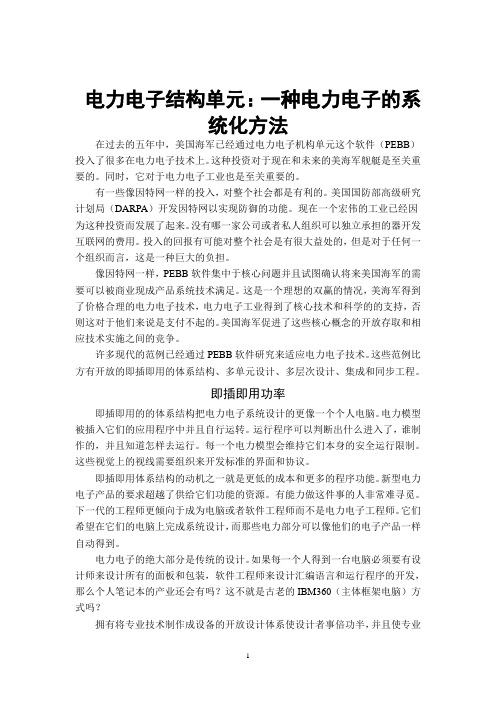
电力电子结构单元:一种电力电子的系统化方法在过去的五年中,美国海军已经通过电力电子机构单元这个软件(PEBB)投入了很多在电力电子技术上。
这种投资对于现在和未来的美海军舰艇是至关重要的。
同时,它对于电力电子工业也是至关重要的。
有一些像因特网一样的投入,对整个社会都是有利的。
美国国防部高级研究计划局(DARPA)开发因特网以实现防御的功能。
现在一个宏伟的工业已经因为这种投资而发展了起来。
没有哪一家公司或者私人组织可以独立承担的器开发互联网的费用。
投入的回报有可能对整个社会是有很大益处的,但是对于任何一个组织而言,这是一种巨大的负担。
像因特网一样,PEBB软件集中于核心问题并且试图确认将来美国海军的需要可以被商业现成产品系统技术满足。
这是一个理想的双赢的情况,美海军得到了价格合理的电力电子技术,电力电子工业得到了核心技术和科学的的支持,否则这对于他们来说是支付不起的。
美国海军促进了这些核心概念的开放存取和相应技术实施之间的竞争。
许多现代的范例已经通过PEBB软件研究来适应电力电子技术。
这些范例比方有开放的即插即用的体系结构、多单元设计、多层次设计、集成和同步工程。
即插即用功率即插即用的的体系结构把电力电子系统设计的更像一个个人电脑。
电力模型被插入它们的应用程序中并且自行运转。
运行程序可以判断出什么进入了,谁制作的,并且知道怎样去运行。
每一个电力模型会维持它们本身的安全运行限制。
这些视觉上的视线需要组织来开发标准的界面和协议。
即插即用体系结构的动机之一就是更低的成本和更多的程序功能。
新型电力电子产品的要求超越了供给它们功能的资源。
有能力做这件事的人非常难寻觅。
下一代的工程师更倾向于成为电脑或者软件工程师而不是电力电子工程师。
它们希望在它们的电脑上完成系统设计,而那些电力部分可以像他们的电子产品一样自动得到。
电力电子的绝大部分是传统的设计。
如果每一个人得到一台电脑必须要有设计师来设计所有的面板和包装,软件工程师来设计汇编语言和运行程序的开发,那么个人笔记本的产业还会有吗?这不就是古老的IBM360(主体框架电脑)方式吗?拥有将专业技术制作成设备的开放设计体系使设计者事倍功半,并且使专业知识可以应用于越来越多的程序。
- 1、下载文档前请自行甄别文档内容的完整性,平台不提供额外的编辑、内容补充、找答案等附加服务。
- 2、"仅部分预览"的文档,不可在线预览部分如存在完整性等问题,可反馈申请退款(可完整预览的文档不适用该条件!)。
- 3、如文档侵犯您的权益,请联系客服反馈,我们会尽快为您处理(人工客服工作时间:9:00-18:30)。
1 Power Electronic ConceptsPower electronics is a rapidly developing technology. Components are tting higher current and voltage ratings, the power losses decrease and the devices become more reliable. The devices are also very easy tocontrol with a mega scale power amplification. The prices are still going down pr. kVA and power converters are becoming attractive as a mean to improve the performance of a wind turbine. This chapter will discuss the standard power converter topologies from the simplest converters for starting up the turbine to advanced power converter topologies, where the whole power is flowing through the converter. Further, different park solutions using power electronics arealso discussed.1.1 Criteria for concept evaluationThe most common topologies are selected and discussed in respect to advantages and drawbacks. Very advanced power converters, where many extra devices are necessary in order to get a proper operation, are omitted.1.2 Power convertersMany different power converters can be used in wind turbine applications. In the case of using an induction generator, the power converter has to convert from a fixed voltage and frequency to a variable voltage and frequency. This may be implemented in many different ways, as it will be seen in the next section. Other generator types can demand other complex protection. However, the most used topology so far is a soft-starter, which is used during start up in order to limit the in-rush current and thereby reduce the disturbances to the grid.1.2.1 Soft starterThe soft starter is a power converter, which has been introduced to fixed speed windturbines to reduce the transient current during connection or disconnection of the generator to the grid. When the generator speed exceeds the synchronous speed, the soft-starter is connected. Using firing angle control of the thyristors in the soft starter the generator is smoothly connected to the grid over a predefined number of grid periods. An example of connection diagram for the softstarter with a generator is presented in Figure1.Figure 1. Connection diagram of soft starter with generators.The commutating devices are two thyristors for each phase. These are connected in anti-parallel. The relationship between the firing angle (﹤) and the resulting amplification of the soft starter is non-linear and depends additionally on the power factor of the connected element. In the case of a resistive load, may vary between 0 (full on) and 90 (full off) degrees, in the case of a purely inductive load between 90 (full on) and 180 (full off) degrees. For any power factor between 0 and 90 degrees, will be somewhere between the limits sketched in Figure 2.Figure 2. Control characteristic for a fully controlled soft starter.When the generator is completely connected to the grid a contactor (Kbyp) bypass the soft-starter in order to reduce the losses during normal operation. The soft-starter is very cheap and it is a standard converter in many wind turbines.1.2.2 Capacitor bankFor the power factor compensation of the reactive power in the generator, ACcapacitor banks are used, as shown in Figure 3. The generators are normally compensated into whole power range. The switching of capacitors is done as a function of the average value of measured reactive power during a certain period.Figure 3. Capacitor bank configuration for power factor compensation in a wind turbine.The capacitor banks are usually mounted in the bottom of the tower or in the nacelle. In order to reduce the current at connection/disconnection of capacitors a coil (L) can beconnected in series. The capacitors may be heavy loaded and damaged in the case of over-voltages to the grid and thereby they may increase the maintenance cost.1.2.3 Diode rectifierThe diode rectifier is the most common used topology in power electronic applications. For a three-phase system it consists of six diodes. It is shown in Figure 4.Figure 4. Diode rectifier for three-phase ac/dc conversionThe diode rectifier can only be used in one quadrant, it is simple and it is not possible to control it. It could be used in some applications with a dc-bus.1.2.4 The back-to-back PWM-VSIThe back-to-back PWM-VSI is a bi-directional power converter consisting of two conventional PWM-VSI. The topology is shown in Figure 5.To achieve full control of the grid current, the DC-link voltage must be boosted to a level higher than the amplitude of the grid line-line voltage. The power flow of the grid side converter is controlled in order to keep the DC-link voltage constant, while the control of the generator side is set to suit the magnetization demand and the reference speed. The control of the back-to-back PWM-VSI in the wind turbine application is described in several papers (Bogalecka, 1993), (Knowles-Spittle et al., 1998), (Pena et al., 1996), (Yifan & Longya, 1992), (Yifan & Longya, 1995).Figure 5. The back-to-back PWM-VSI converter topology.1.2.4.1 Advantages related to the use of the back-to-back PWM-VSIThe PWM-VSI is the most frequently used three-phase frequency converter. As a consequence of this, the knowledge available in the field is extensive and well established. The literature and the available documentation exceed that for any of the other converters considered in this survey. Furthermore, many manufacturers produce components especially designed for use in this type of converter (e.g., a transistor-pack comprising six bridge coupled transistors and anti paralleled diodes). Due to this, the component costs can be low compared to converters requiring components designed for a niche production.A technical advantage of the PWM-VSI is the capacitor decoupling between the grid inverter and the generator inverter. Besides affording some protection, this decoupling offers separate control of the two inverters, allowing compensation of asymmetry both on the generator side and on the grid side, independently.The inclusion of a boost inductance in the DC-link circuit increases the component count, but a positive effect is that the boost inductance reduces the demands on the performance of the grid side harmonic filter, and offers some protection of the converter against abnormal conditions on the grid.1.2.4.2 Disadvantages of applying the back-to-back PWM-VSIThis section highlights some of the reported disadvantages of the back-to-back PWM-VSI which justify the search for a more suitable alternative converter: In several papers concerning adjustable speed drives, the presence of the DClink capacitor is mentioned as a drawback, since it is heavy and bulky, it increases the costs andmaybe of most importance, - it reduces the overall lifetime of the system. (Wen-Song & Ying-Yu, 1998); (Kim & Sul, 1993); (Siyoung Kim et al., 1998).Another important drawback of the back-to-back PWM-VSI is the switching losses. Every commutation in both the grid inverter and the generator inverter between the upper and lower DC-link branch is associated with a hard switching and a natural commutation. Since the back-to-back PWM-VSI consists of two inverters, the switching losses might be even more pronounced. The high switching speed to the grid may also require extra EMI-filters.To prevent high stresses on the generator insulation and to avoid bearing current problems (Salo & Tuusa, 1999), the voltage gradient may have to be limited by applying an output filter.1.2.5 Tandem converterThe tandem converter is quite a new topology and a few papers only have treated it up till now ((Marques & Verdelho, 1998); (Trzynadlowski et al., 1998a); (Trzynadlowski et al., 1998b)). However, the idea behind the converter is similar to those presented in ((Zhang et al., 1998b)), where the PWM-VSI is used as an active harmonic filter to compensate harmonic distortion. The topology of the tandem converter is shown in Figure 6.Figure 6. The tandem converter topology used in an induction generator wind turbine system.The tandem converter consists of a current source converter, CSC, in the following designated the primary converter, and a back-to-back PWM-VSI, designated the secondary converter. Since the tandem converter consists of four controllable inverters, several degrees of freedom exist which enable sinusoidal input and sinusoidal output currents. However, in this context it is believed that the most advantageous control of the inverters is to control the primary converter to operate in square-wave current mode. Here, the switches in the CSC are turned on and off only once per fundamental period of the input- and output current respectively. In square wave current mode, the switches in the primary converter may either be GTO.s, or a series connection of an IGBT and a diode.Unlike the primary converter, the secondary converter has to operate at a high switching frequency, but the switched current is only a small fraction of the total load current. Figure 7 illustrates the current waveform for the primary converter, the secondary converter, is, and the total load current il.In order to achieve full control of the current to/from the back-to-back PWMVSI, the DC-link voltage is boosted to a level above the grid voltage. As mentioned, the control of the tandem converter is treated in only a few papers. However, the independent control of the CSC and the back-to-back PWM-VSI are both well established, (Mutschler & Meinhardt, 1998); (Nikolic & Jeftenic, 1998); (Salo & Tuusa, 1997); (Salo & Tuusa, 1999).Figure 7. Current waveform for the primary converter, ip, the secondary converter, is, and the total load current il.1.2.5.1Advantages in the use of the Tandem ConverterThe investigation of new converter topologies is commonly justified by thesearch for higher converter efficiency. Advantages of the tandem converter are the low switching frequency of the primary converter, and the low level of the switched current in the secondary converter. It is stated that the switching losses of a tandem inverter may be reduced by 70%, (Trzynadlowski et al., 1998a) in comparison with those of an equivalent VSI, and even though the conduction losses are higher for the tandem converter, the overall converter efficiency may be increased.Compared to the CSI, the voltage across the terminals of the tandem converter contains no voltage spikes since the DC-link capacitor of the secondary converter is always connected between each pair of input- and output lines (Trzynadlowski et al., 1998b).Concerning the dynamic properties, (Trzynadlowski et al., 1998a) states that the overall performance of the tandem converter is superior to both the CSC and the VSI. This is because current magnitude commands are handled by the voltage source converter,while phase-shift current commands are handled by the current source converter (Zhang et al., 1998b).Besides the main function, which is to compensate the current distortion introduced by the primary converter, the secondary converter may also act like an active resistor, providing damping of the primary inverter in light load conditions (Zhang et al., 1998b). 1.2.5.2 Disadvantages of using the Tandem ConverterAn inherent obstacle to applying the tandem converter is the high number of components and sensors required. This increases the costs and complexity of both hardware and software. The complexity is justified by the redundancy of the system (Trzynadlowski et al., 1998a), however the system is only truly redundant if a reduction in power capability and performance is acceptable.Since the voltage across the generator terminals is set by the secondary inverter, the voltage stresses at the converter are high. Therefore the demands on the output filter are comparable to those when applying the back-to-back PWM-VSI.In the system shown in Figure 38, a problem for the tandem converter in comparison with the back-to-back PWM-VSI is the reduced generator voltage. By applying the CSI as the primary converter, only 0.866% of the grid voltage can be utilized. This means that the generator currents (and also the current through the switches) for the tandem converter must be higher in order to achieve the same power.1.2.6 Matrix converterIdeally, the matrix converter should be an all silicon solution with no passive components in the power circuit. The ideal conventional matrix converter topology is shown in Figure 8.Figure 8. The conventional matrix converter topology.The basic idea of the matrix converter is that a desired input current (to/from the supply), a desired output voltage and a desired output frequency may be obtained by properly connecting the output terminals of the converter to the input terminals of the converter. In order to protect the converter, the following two control rules must be complied with: Two (or three) switches in an output leg are never allowed to be on at the same time. All of the three output phases must be connected to an input phase at any instant of time. The actual combination of the switches depends on the modulation strategy.1.2.6.1 Advantages of using the Matrix ConverterThis section summarises some of the advantages of using the matrix converter in the control of an induction wind turbine generator. For a low output frequency of the converter the thermal stresses of the semiconductors in a conventional inverter are higher than those in a matrix converter. This arises from the fact that the semiconductors in a matrix converter are equally stressed, at least during every period of the grid voltage, while the period for the conventional inverter equals the output frequency. This reduces the thermal design problems for the matrix converter.Although the matrix converter includes six additional power switches compared to the back-to-back PWM-VSI, the absence of the DC-link capacitor may increase the efficiency and the lifetime for the converter (Schuster, 1998). Depending on the realization of the bi-directional switches, the switching losses of the matrix inverter may be less than thoseof the PWM-VSI, because the half of the switchings become natural commutations (soft switchings) (Wheeler & Grant, 1993).1.2.6.2 Disadvantages and problems of the matrix converterA disadvantage of the matrix converter is the intrinsic limitation of the output voltage. Without entering the over-modulation range, the maximum output voltage of the matrix converter is 0.866 times the input voltage. To achieve the same output power as the back-to-back PWM-VSI, the output current of the matrix converter has to be 1.15 times higher, giving rise to higher conducting losses in the converter (Wheeler & Grant, 1993).In many of the papers concerning the matrix converter, the unavailability of a true bi-directional switch is mentioned as one of the major obstacles for the propagation of the matrix converter. In the literature, three proposals for realizing a bi-directional switch exists. The diode embedded switch (Neft & Schauder, 1988) which acts like a true bi-directional switch, the common emitter switch and the common collector switch (Beasant et al., 1989).Since real switches do not have infinitesimal switching times (which is not desirable either) the commutation between two input phases constitutes a contradiction between the two basic control rules of the matrix converter. In the literature at least six different commutation strategies are reported, (Beasant et al., 1990); (Burany, 1989); (Jung & Gyu, 1991); (Hey et al., 1995); (Kwon et al., 1998); (Neft & Schauder, 1988). The most simple of the commutation strategies are those reported in (Beasant et al., 1990) and (Neft & Schauder, 1988), but neither of these strategies complies with the basic control rules.1 电力电子技术的内容电力电子技术是一门正在快速发展的技术,电力电子元器件有很高的额定电流和额定电压,它的功率减小元件变得更加可靠、耐用.这种元件还可以用来控制比它功率大很多倍的元件。
